Health Articles
Find out more about your health here from our health professionals!
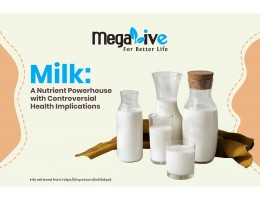
Milk: A Nutrient Powerhouse with Controversial Health Implications
Milk is renowned as a nutritional powerhouse, often considered the food with the highest nutrient density, making it a natural dietary staple for infants from ancient times. This association continues to hold true, as milk is the preferred oral nutrition supplement for bedridden patients (1).
Nonetheless, the role of milk in adult diets remains a topic of debate. Some studies argue that daily milk consumption is unnecessary, while others advocate for its regular inclusion (1). Here, we present a breakdown of the considerations to help you decide whether daily milk intake is right for you.

Milk and Obesity
Despite the common perception that full-fat dairy products contribute to weight gain, research has revealed a contrary perspective. In fact, full-fat dairy products might be more effective in weight management than their low-fat counterparts. Walter Willet, a nutrition expert from Harvard School of Public Health, clarifies that the demonization of all fats emerged in the 1950s and 1960s when saturated fats were linked to high cholesterol and increased heart disease risk (2).
However, reducing saturated fat in food products or diets often leads to their replacement with sugars or carbohydrates. The downside to this substitution is that carbohydrates do not provide the same feeling of fullness as fats, causing increased food consumption (2). Some studies even suggest that the more sugar we consume, the stronger our cravings become, akin to an addiction (3).

Modern Milk Dilemma
Modern milk options have evolved to cater to various preferences and dietary needs, from animal-based milk to plant-based alternatives. The variety of choices makes selecting the right milk a bit tricky, especially given the differing nutritional profiles.
Choosing the Right Milk
If your goal is to use milk to promote a sense of fullness and avoid excessive food intake, full cream milk is a suitable choice. However, be mindful of monitoring your overall calorie intake and opt for milk with lower sugar content. On the other hand, if you tend to obtain fats from other food sources, opting for low-fat milk is advisable while remaining vigilant about sugar content. In essence, prioritize milk with minimal sugar, saturated fat, and trans-fat content, as these components have been associated with various health complications.
Plant-based milk alternatives may not necessarily be healthier than cow's milk, as they could contain higher sugar levels. However, they are an environmentally friendly choice, with soy milk, almond milk, oat milk, and rice milk producing fewer carbon emissions and greenhouse gases compared to cow's milk.
Pros and Cons of Milk
The decision of whether to incorporate milk into your daily diet remains a subject of debate. Factors such as your dietary intake and body weight play a pivotal role in determining the daily milk consumption that suits you. For individuals with normal weight, one glass of milk per day may suffice, while those who are underweight might consider upping their intake to two glasses. Yet, it is essential to balance the intake of beneficial fats from milk with the reduction of harmful fats from sources such as deep-fried foods, foods high in trans-fats, and those with high saturated fat content.
In Malaysia, where a significant portion of the population is overweight or obese, reconsidering daily milk consumption may be prudent. The key is to ensure you meet your daily calcium requirements, which can also be obtained from alternative sources like anchovies, sardines, almonds, kale, and various other foods (5,6).

Fact Check (5,6)
-
Saturated fat is often high in animal-based and certain plant-based foods, such as coconut milk (santan). Excessive intake is linked to elevated blood cholesterol levels and an increased risk of heart disease. Notably, many coconut milk products claim to be cholesterol-free, despite containing high levels of saturated fat.
-
Trans fat is a man-made fat produced through hydrogenation, which raises bad (LDL) cholesterol and lowers good (HDL) cholesterol levels. Consuming trans fats increases the risk of heart disease, stroke, and type 2 diabetes. Examples of foods that may contain trans fats include doughnuts, cookies, crackers, muffins, pies, fast food, and cakes.

References
- Ask the Experts: Is Milk is good for you? https://www.healthline.com/health/food-nutrition/experts-is-milk-good-for-you (Accessed on November 23, 2020).
- Harvard T.H. Chan School Public Health. Calcium and Milk. https://www.hsph.harvard.edu/nutritionsource/what-should-you-eat/calcium-and-milk/ (Accessed on November 24, 2020).
- Avena, N. M., Rada, P., & Hoebel, B. G. (2008). Evidence for sugar addiction: behavioral and neurochemical effects of intermittent, excessive sugar intake. Neuroscience and biobehavioral reviews, 32(1), 20–39. https://doi.org/10.1016/j.neubiorev.2007.04.019
- Harvard T.H. Chan School of Public Health. Milk not necessary for adult, should be good option for kids. https://www.hsph.harvard.edu/news/hsph-in-the-news/milk-health-adults-kids/ (Accessed on November 20, 2020)
- Ministry of Health (MOH). Fats and cholesterol. http://www.myhealth.gov.my/en/dietary-for-hypercholesterolemia/ (Accessed on November 23, 2020).
- American Heart Association (AHA). Trans Fat. https://www.heart.org/en/healthy-living/healthy-eating/eat-smart/fats/trans-fat (Accessed on November 24, 2020).

Boost your kids’ immune health
- Guard against germ spread.
Fighting germs does not technically boost immunity, but it is a great way to reduce stress on your child’s immune system. Make sure your children wash their hands often (with soap) especially before and after using toilet, before and after meals, after playing outside, arrive home from day care, handling pets, or blowing their nose. To cultivate the habits, you may also let them pick up their own choice of handkerchief, soap, and scents!
You must also always make sure that your hands are clean before you touch them!
Whenever you are bringing them outside make sure you carry antibacterial disposable wet wipes with you for your quick clean ups. Oh, you may also practice to let your children wear face shield if you are outside or in public area if they cannot wear mask yet! Make sure to sanitize or clean the face shield frequently and keep it properly as well!

Another key germ busting strategy according to health professionals is whenever your child is sick throw away their toothbrush as the germs from outside or from the toothbrush can hop from toothbrush to toothbrush infecting other family members. If it is a bacterial infection, such as strep throat, your child can reinfect themselves with the same germs that got them sick in the first place. In that case, tossing the toothbrush protects both your child and the rest of your family.
- Make sure your children eat healthily.
It is normal for kids to dislike healthy foods if the parents dislike it, or rarely consume it! If you feel like your children eating habit are more into unhealthy habit check back your food preference most of the times it is a reflection!
Try to eat healthily as much as you can, make sure that every main mealtime there is vegetables and fruit serve for your whole family, it can be just a simple blanched carrot and broccoli, or it can be stir fried vegetables or it can be simply raw salad with dressings! If your children are okay with consuming vegetables and fruits in every main mealtime, start introducing healthy snacks using fruits and vegetables as well.
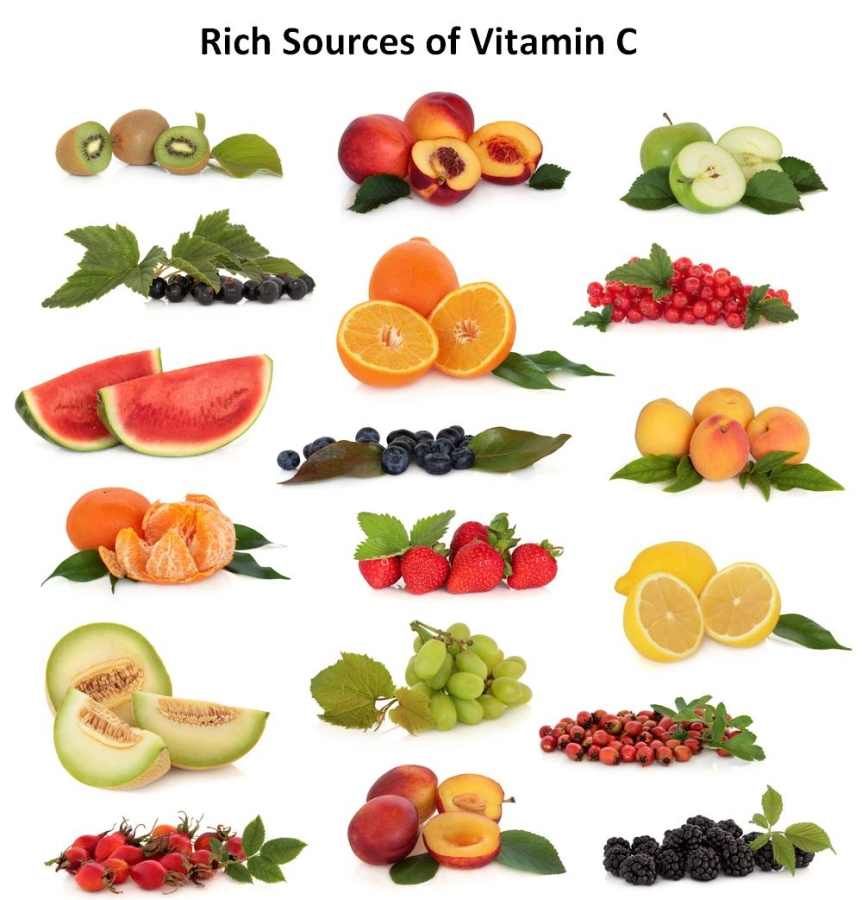
They may eat cakes, biscuits, and dessert occasionally still! If your children are still below 6 months young, try to breastfeed them as much as you can, as breastmilk has naturals antibody which is passed from mothers to baby which is beneficial for children during this pandemic situation.
Apart from vegetables and fruits, consuming yogurt which contains high amount of probiotics and prebiotics also helps with immune health.
- Boost sleep time!
Studies show that sleep deprivation make individuals more susceptible to illness by reducing natural killer cells (immune-system weapons that attack microbes and cancer cells). Required sleeping hours for children is vary according to their age, but on average children need to nap during the day for at least one hour and sleep throughout the night for at least 10 hours.
Try to help your children into having a fixed routine helps with their sleeping time. Try to tone down screen time and makes them do a lot of physical activity in the evening also helps with sleeping earlier during the night. Children who does not nap during the day may sleep even earlier at night according to expert, but still nap is important for children, which is why try to cultivate habits which makes them easier to nap during the day. This will not only be beneficial for their immunity but as well as for their growth and development.
References.
- 7 Ways to Boost Immunity for your child’s Immunity. https://www.parents.com/health/cold-flu/cold/boost-childs-immunity/ (Accessed on Feb 15, 2021).
- Cleveland Clinic. Health Essentials. How to boost your kids’ immunity heading into the new school year. https://health.clevelandclinic.org/how-to-boost-your-kids-immunity-heading-into-the-new-school-year/ (Accessed on Feb 15, 2021).
- Grow by WebMD. Immunity bosting snacks for kids. https://www.webmd.com/parenting/features/immune-system#1 (Accessed on Feb 15, 2021).

Constipation in Children: What to Do?
Constipation is common among children. As parents, you may notice that your child has constipation if:
- They have not pooped in at least three days.
-
Their poop is large and hard; it looks like rabbit droppings or little pellets.
-
They are straining or in pain when they poop.
-
They may have some bleeding during or after pooping because their poop is hard.
Another sign to look for is when a child has a poor appetite or stomach pain that improves after they poop. Soiled pants are one of the symptoms of constipation in children aged one and up, as runny poop may leak around the hard constipated poop. This is called overflow soiling.
Constipation is common in toddlers aged 2 to 3 years old, according to health professionals. This is because usually at this age, parents start to potty train their children, which makes them feel uneasy about the whole poop situation.
Here are some tips that you may try to prevent your child from experiencing constipation or to help them while they are constipated.
-
Make sure they drink plenty of fluid. Most of the time, children are unable to tell you if they are thirsty, especially if they are merely 1 year old. One of the tips that we can practice is to always make sure their sippy cup is full and within their reach so that it will be easier for them to drink water whenever they want. Sometimes children are so occupied with playing that they do not drink water, so it is best to remind them every few hours to drink water.
-
Consume a high-fiber diet. This means to load your child's plate with plenty of fresh fruits and vegetables, high-fiber cereals, whole-grain breads (look for at least 3-5g of fiber per serving), and a variety of beans and legumes, such as lentils and chickpeas. One of the good sources of fiber that children love most is popcorn (but prepare it with the minimum amount of sugar, butter, and salt). You may also let them prepare their own popcorn or fruit salad; this will even stimulate their appetite, and of course they will learn and enjoy the process. Foods containing probiotics, such as yogurt, can also promote good digestive health.
-
Doing a lot more physical activity. Sedentism can also be detrimental to bowel movements. Children under the age of five require at least three hours of physical activity per day. So, let them move around, let them jump and climb, but keep in mind that all of this must be monitored and done in a safe environment, especially for young toddlers.
-
Regular toilet time. This is especially true for children who are undergoing toilet training. Encourage your child to use the toilet first thing in the morning and after every meal or snack. Set a timer for every 30 to 45 minutes to take them to the bathroom. Instead of suggesting, "Do you need to go to the bathroom?" simply say, "Time to go to the bathroom now." Having regular toilet time also means helping them have regular time for everything else, such as their mealtimes and their naps. This will also help them easily adapt to this new habit of going to the toilet whenever they feel the urge.
-
Stool softener to clear the bowels. These are safe for children, but they need to be used under the supervision of a doctor or pharmacist. A common mistake when it comes to using stool softener is that parents tend to stop using it after their child has their first normal-looking bowel movement, but stopping too soon may just set your child up for another episode of constipation. So, what you can do is talk to your doctor; it is okay to let your child stay on stool softener for a few weeks. At the same time, try your best to cultivate lifestyle and dietary changes that can improve your child's bowel movements.
In conclusion, always try to monitor your child's bowel movements so you may notice any changes, especially if they are under 2 years old, as they cannot verbally tell what is going on in their body or if they are in pain. Noticing it early will allow you to better prepare to assist them in relieving their bowel condition than if it is already chronic. Also, if it has been too long already or if your child is in pain whenever you press their abdomen (to this extent), it is best to seek advice from a doctor regarding your child's condition.
References.
-
National Health Service (NHS) U.K. Constipation in children. https://www.nhs.uk/conditions/baby/health/constipation-in-children/ (Accessed on April 1, 2021).
-
National Institute of Diabetes, Digestive and Kidney Disease (NIDDK). U.S Department of Health and Human Services. Symptoms and Causes of Constipation in Children. https://www.niddk.nih.gov/health-information/digestive-diseases/constipation-children/symptoms-causes (Accessed on April 1, 2021).
-
Mayo Clinic. Constipation in Children. https://www.mayoclinic.org/diseases-conditions/constipation-in-children/symptoms-causes/syc-20354242#:~:text=Constipation%20in%20children%20is%20a,constipation%20in%20children%20are%20temporary. (Accessed on April 1, 2021).
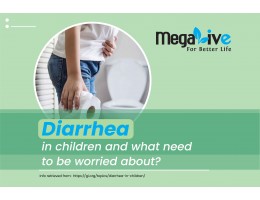
Diarrhea in children and what need to be worried about?
Diarrhea is characterized by frequent soft or loose bowel movements (poop). Most children experience diarrhea from time to time. It usually does not last long and usually resolves on its own, but in children, the period when they have diarrhea is critical because they may be losing too much water, which can lead to other health problems.
Among the dehydration symptoms that parents and/or caregivers should look for in children who have diarrhea are:
- Seems drowsy
- Breathes quickly
- Has few or no tears when they cry
- Has a soft spot on their head that sinks inwards (sunken fontanelle)
- Has a dry mouth
- Has dark yellow pee or has not had a pee in the last 6 hours (for baby) and 12 hours (for child)
- Hands and feet that appear cold and blotchy

Diarrhea is usually caused by an infection, such as rotavirus, bacteria like salmonella, or a parasite like giardia. Aside from dehydration symptoms, it also includes vomiting, stomachache, headache, and fever.
It is also critical to seek medical attention right away if your child or baby exhibits any of the following symptoms:
- A fever of 38°C or higher.
- Diarrhea lasting more than 24 hours.
- Has more than four diarrhea stools in eight hours and isn't drinking enough.
- Bloody or pustular stools
It is best to prevent fluid loss when treating diarrhea in children or adults, whether in a clinical setting or at home.
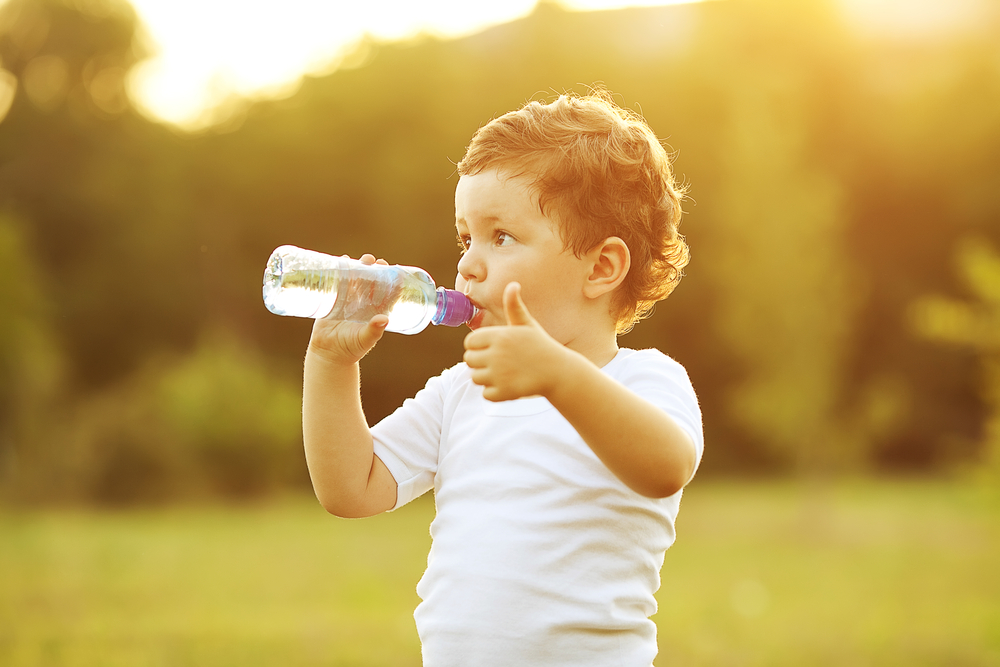
Here are some tips that parents and/or caregivers can use to prevent fluid loss at home:
- Provide more fluids and encourage your child to drink more. Infants and children should be given extra breast milk or oral rehydration solution (ORS). Plain water lacks minerals like sodium and potassium, both of which can help with diarrhea. Fruit juice and carbonated drinks are not recommended because they cause stomach ache/ cramps and increase fluid loss (the later). Children with severe diarrhea, vomiting, and dehydration may require intravenous fluids (via a vein in the arm) in the hospital.
- It is also critical to begin providing a consistent diet for the children. Encourage them to eat small amounts of food frequently, even if they don't have an appetite. Breastfed babies can continue to nurse normally, and formula-fed babies can eat normally as well. Smaller, more frequent meals are once again encouraged. Water-rich foods, such as watermelon, are also encouraged.
In conclusion, diarrhea in children can be very serious and is quite common; some of the practices that parents may employ when dealing with children who frequently experience diarrhea include ensuring that their children's and caregiver's hygiene is always maintained. Ensure that food is stored at the proper temperature, particularly dairy and raw food products; that food is fully cooked; and that the home environment is clean, especially if there is a pet in the same household. Aside from these, taking probiotic supplements is beneficial to their gut health.
References
- American College of Gastroenterology. Diarrhea in children. https://gi.org/topics/diarrhea-in-children/ (Accessed on April 1, 2021).
- National Collaborating Centre for Women’s and Children’s Health (UK). Diarrhoea and Vomiting Caused by Gastroenteritis: Diagnosis, Assessment and Management in Children Younger than 5 Years. London: RCOG Press; 2009 Apr. (NICE Clinical Guidelines, No. 84.) 5, Fluid management.Available from: https://www.ncbi.nlm.nih.gov/books/NBK63837/
- National Institute of Health (NIH). National Institute of Diabetes, Digestive, and Kidney Disease (NIDDK). Symptoms and causes of chronic diarrhea in children. https://www.niddk.nih.gov/health-information/digestive-diseases/chronic-diarrhea-children/symptoms-causes (Accessed on April 1, 2021).
- National Health Service (NHS) U. Dehydration. https://www.nhs.uk/conditions/dehydration/ (Accessed on April 1, 2021).
- Diarrhea in Children. https://www.webmd.com/children/guide/diarrhea-treatment (Accessed on April 1, 2021).
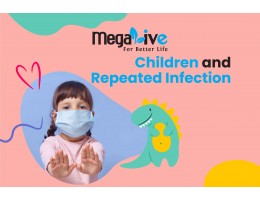
Children and repeated infections
However, it is not practical to avoid your children from all the exposure altogether since exposure to all these things are somewhat things that build up their immune health stronger and better, but we must control the exposure and make sure that their immune health is strong enough to fight the infection.
Here are some tips that you may practice to help your children to stay as healthy as possible:
- Make sure that your child get all the required vaccines under the National Immunization Program. You may also add more vaccines based on your child condition and needs but talk to your pediatrician first!

- Make sure that your child is getting the nutrition that they need to help them with their immune system. Ensure that your child get enough protein, fiber, vitamins, and minerals. Minimize sugar and processed foods as their tummy is only little if they fill it with all these unhealthy stuff they will have no appetite anymore for nutritious foods. Encourage children to consume fruits such as orange, kiwi, and guava that is rich with vitamin C. Limit the intake of dessert, sugary drinks, sausage, meatballs etc.

- Discourage the habit of thumb sucking or using pacifier as your infant gets older, as a contaminated finger, thumb, or pacifier can be a route for germs transmission which can lead to infection.
- Always keep your child’s utensils and bottle clean. If you are still breastfeeding your child, or is using breastmilk pump, make sure you frequently boiled it, or steam all the equipment.
- Try to instils good hygiene practice since young, such as wash hands as soon as reach home, after going to the toilet, and whenever they sneeze or cough and covered it with their hand.

Most importantly, understand that frequent infections are very common in the first two years of life especially if they are in day care with many other children and after they no longer breastfed. All in all, all these will help them to make their immune health better but at the same time as a parents we need to help the children to build their immune health by providing nutritious foods, clean environment and instill good hygiene practice.

Understanding acid reflux in children
Acid reflux, also known as gastroesophageal reflux (GER), is a condition that affects both adults and children. While the fundamental mechanism remains the same, there are notable distinctions between acid reflux in adults and its manifestation in children.
In adults, reflux occurs when stomach contents, including stomach acid, flow back into the esophagus, leading to symptoms such as heartburn, regurgitation, and a bitter taste in the mouth.
This uncomfortable condition is not limited to adults; it can also affect children and even infants. However, due to the differences in the maturity of their digestive systems, the symptoms of GER can vary significantly depending on the child's age.
In infants, a certain amount of spit-up after feeding is common and referred to as GER. Nevertheless, if your baby experiences frequent vomiting accompanied by discomfort, feeding difficulties, or weight loss, it may signify a more serious issue than typical GER. Nevertheless, the underlying mechanism of GER in babies, children, and adults remains quite similar.
For babies, GER often results from their underdeveloped gastrointestinal tract, which is not as coordinated as an adult's. In contrast, children may experience GER due to factors like obesity, overeating, consumption of spicy or oily foods, intake of caffeinated or carbonated beverages, or the use of specific medications. Nonetheless, the root cause of GER in children is akin to that in adults: it occurs when factors induce relaxation of the muscular valve between the stomach and esophagus (known as the Lower Esophageal Sphincter or LES) or elevate pressure below the LES.
Symptoms in Children:
The most common GER symptoms in infants and children include:
- Frequent or recurrent vomiting
- Persistent cough or wheezing
- Feeding difficulties, such as choking or gagging during meals
- Heartburn, gas, abdominal pain, and colic
- Regurgitation and re-swallowing
- Complaining of a sour taste in the mouth, especially in the morning
Tips for Identifying and Assisting Children with GER:
When it comes to children, paying close attention to their complaints or observations is crucial. Children often struggle to articulate their discomfort or pain accurately. In addition to this, there are several strategies that can help manage GER in children:
- Encourage children to sit upright for at least two hours after meals, particularly if they have consumed trigger foods like oily or spicy dishes, carbonated beverages, or caffeine.
- Opt for several small meals throughout the day instead of three large ones.
- Ensure that children do not overeat.
- Promote regular exercise among children.
For infants, elevating the crib or bassinet and holding the baby upright for 30 minutes after feeding can be beneficial, along with assisting them in burping.
In conclusion, acid reflux, a condition commonly associated with adults, can also affect children. However, children may struggle to describe their symptoms and understand what is happening to their bodies. The key lies in attentive observation and implementing the helpful tips mentioned above to provide relief and comfort to children experiencing GER.
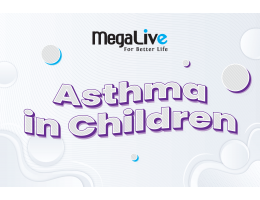
Asthma in Children
What is asthma in children?
Asthma is a major non-communicable disease (NCD), affecting children and adults. It is a condition in which the airway in the lung narrows due to inflammation and tightening of the muscle surrounding the small airway. As a result, asthma symptoms such as coughing, wheezing, shortness of breath, and chest tightness developed. These symptoms are usually on and off, while the asthma disease itself is a long-term condition. Asthma triggers vary from person to person, but they can also be due to a viral infection (cold), dust, smoke, fumes, changes in the weather, grass and tree pollen, feathers, strong soap, perfume, animal fur, and many more.
Causes of asthma in children.
Although it is often difficult to find a single, direct cause, it is believed to have multiple complex causes. Many factors have been linked to an increased risk of developing asthma, such as
- Have a close family member with asthma and/or eczema, such as parents or siblings
- Have other allergic conditions such as rhinitis, etc.
- Urbanization is associated with increased asthma prevalence, probably due to multiple lifestyle factors.
- Events in early life affect the developing lungs and can increase the risk of asthma. These include low birth weight, premature birth, exposure to tobacco smoke and other sources of air pollution, as well as viral respiratory infections.
- Exposure to a range of environmental allergens and irritants is also thought to increase the risk of asthma, including indoor and outdoor air pollution, house dust mites, molds, and occupational exposure to chemicals, fumes, or dust.
Prevention & Control of asthma
Asthma cannot be cured, but good management with inhaled medications can control the disease and enable people with asthma to enjoy a normal, active life.
There are two main types of inhalers:
- Bronchodilators (such as Salbutamol), that open the air passages and relieve symptoms
- Steroids (such as Beclomethasone), that reduce inflammation in the air passages. This improves asthma symptoms and reduce the risk of severe asthma attack and death.
People with asthma may need to use an inhaler every day. Their treatment will depend on the frequency of symptoms and the types of inhalers available.
It can be difficult to coordinate breathing using an inhaler, especially for children and during emergency situations. Using a "spacer" device makes it easier to use an aerosol inhaler and helps the medicine reach the lung more effectively.
People with asthma may need to use an inhaler every day. Their treatment will depend on the frequency of symptoms and the types of inhalers available.
It can be difficult to coordinate breathing using an inhaler, especially for children and during emergency situations. Using a "spacer" device makes it easier to use an aerosol inhaler and helps the medicine reach the lung more effectively.
Other than this, it is also best to avoid triggers for asthma. Triggers vary from person to person; as asthmatic children grow; parents should be able to identify things that trigger their asthma attack. It can be as simple as changes in weather, temperature, etc.
In conclusion, since asthma is a lifelong disease, it is best to manage or control it by avoiding triggers in children and by adhering to the medication based on a doctor's suggestion.
References
- World Health Organization (WHO). Asthma. https://www.who.int/news-room/fact-sheets/detail/asthma
- Mayo Clinic. Childhood Asthma. https://www.who.int/news-room/fact-sheets/detail/asthma
- Better Health Chanel. Asthma in children. https://www.betterhealth.vic.gov.au/health/conditionsandtreatments/asthma-in-children#causes-of-asthma-in-children

Your Prostate Health Matters!
Many men do not care about or even know the importance of their reproductive organs, especially the prostate gland. The prostate gland has an important job, which is to produce a thick, milky-white fluid that becomes part of the semen, the liquid ejaculated during sexual activity. The prostate isn’t that big—about the size of a walnut or golf ball. The prostate is located just below the bladder and in front of the rectum. It also wraps around the upper part of the urethra, the tube that carries urine from the bladder out of the body. That means prostate problems can affect urination and sexual function.
What are the problems? If your "man" has problems like pain during urination or often urinates at night, you have to check and detect the problem early and take precautions. While you may not have any problems related to this, you have to know ways to prevent them from developing.
Benign Prostatic Hyperplasia
Is extremely common in older men. It is not cancerous, but it has the characteristic of enlarging the organ. The prostate goes through a period of rapid enlargement during puberty, but this levelled off once puberty was completed. The prostate will begin to grow again in midlife, but at a slower rate. These periods of growth are thought to be caused by increased levels of male hormones such as testosterone. The prostate grows throughout a man's life because testosterone is produced throughout his life.
The most common symptom of BPH is difficulty urinating or dribbling after you urinate. Also, you may feel the need to urinate a lot, often at night (5).
Prostatitis
It starts with a bacterial infection or prostate inflammation. Prostatitis can result in burning or painful urination, an urgent need to urinate, difficulty urinating, difficult or painful ejaculation, and pain between the scrotum and the rectum or in the lower back. Prostatitis is classified into two types: acute bacterial prostatic and chronic bacterial prostatic. It only causes mild urination difficulties and can cause fever, chills, or pain. A bacterial infection is also the starting point. The second is chronic bacterial prostatic disease, which occurs when an infection recurs frequently. This is a rare and difficult to treat condition. To feel better, you may need to consult your doctor (5).
Prostate Cancer
It is the most common type of male cancer. Prostate cancer typically grows slowly and is initially confined to the prostate gland, where it may not cause significant harm. The development of cancerous cells within the prostate gland, which may spread to other parts of the body. While some types of prostate cancer grow slowly and may require little or no treatment, others are aggressive and spread quickly. It primarily affects older men (1, 5).
Here are a few simple tips on how you can manage or care for your prostate gland. There is also a way to prevent it.
Healthy Eating – Better Health!
First and foremost, you must strive for a healthy eating pattern, which is easier than you might think. Adhering to a heart-healthy, low-animal-fat, low-carbohydrate diet. You must substitute whole-grain bread for white bread, as well as whole-grain pasta and cereal. Choose healthy fats like olive oil, nuts (almonds, walnuts, and pecans), and avocados. Limit your intake of saturated fats from dairy and other animal products. Avoid partially hydrogenated fats (trans fats), which are found in many processed foods and fast foods. Fruits and vegetables high in antioxidants are always beneficial to your body in preventing cancer-causing oxidants. Consume more fish because it contains omega-3 fatty acids. Because obesity has been linked to prostate problems, you should limit your sugar intake as well. Avoid sugar-sweetened beverages such as sodas and many fruit juices (1, 2, 3, 4).
Exercise For Everyone!
You should stay active in addition to eating a healthy diet. Regular exercise will lower your risk of developing certain problems, such as heart disease, stroke, and certain types of cancer. Although relatively few studies have directly assessed the impact of exercise on prostate health, those that have concluded that exercise is beneficial in the majority of cases.
If you have any kind of symptom, such as pain when urinating, you urinate frequently, especially at night. Screening for prostate problems is recommended between the ages of 55 and 70. Your doctor may perform a rectal exam as a physical test and blood testing for prostate-specific antigen (PSA) (5).
References
- Jennifer H. Cohen, Alan R. Kristal, Janet L. Stanford. (2000). Fruit and Vegetable Intakes and Prostate Cancer Risk. Vol 92. Issue 1 (61-68) https://academic.oup.com/jnci/article/92/1/61/2905797
- Katie M. Di Sebastiono, Marina Mourtzakis. (2014). The Role of Dietary Fat throughout the Prostate Cancer Trajectory. https://www.ncbi.nlm.nih.gov/pmc/articles/PMC4277017/
- Paul Turek. (2014). How To Keep Your Prostate Happy https://www.urologyhealth.org/careblog/how-to-keep-your-prostate-happy
- Harvard Health (n.d). 10 Diet & Exercise Tips for Prostate Health. https://www.health.harvard.edu/mens-health/10-diet-and-exercise-tips-for-prostate-health
- MedicineNet (n.d). Prostate Problems. https://www.medicinenet.com/prostate_problem_warning_signs/article.htm

Erectile Dysfunction: Is it taboo or a health concern?

Globally, it is estimated that 100 million men have ED problems, but even with such a figure, ED is considered a taboo topic to discuss because it is considered an embarrassment, and people do not want to seek medical help for it. It is not taboo to discuss ED because it is a health issue. Sexual well-being is one component of overall health, and as we age, our bodies do not function as well as they used to, which is why ED is common in men aged 40 and older.
ED can be caused by a variety of factors, including physical, psychological, and social factors. Physical factors such as heart disease, atherosclerosis, high blood pressure, diabetes, high cholesterol, obesity, Parkinson's disease, multiple sclerosis, liver or kidney problems, Peyronie's disease, and alcoholism are common among older men. These medical conditions typically affect the nerves and blood vessels that control erections, which explains why people with such conditions are more likely to develop ED. Psychological factors can also contribute to ED. Worry about being unable to achieve or maintain an erection, as well as prolonged emotional distress related to economic, professional, social issues, relationship conflicts, and depression can all distract a man of any age from becoming aroused.
Stendra (avanafil), Viagra (sildenafil), Cialis (tadalafil), and Levitra or Staxyn (vardenafil) are some of the most commonly prescribed erectile dysfunction treatments. Aside from medication, lifestyle changes such as exercise, healthy eating, stress management, and adequate sleep will also aid in the treatment of this condition.
According to the study, not all types of exercise help with ED; exercise such as cycling might not be helpful for ED, according to the National Health Service, UK; however, weight-bearing exercise can increase the natural production of testosterone, which is a significant factor in erectile strength and sex drive. Apart from weight-bearing exercise, kegel exercises, which improve your pelvic floor, yoga, and aerobic exercise, which are targeted to improve stamina and overall fitness, also help. In general, exercise will improve sexual health as it improves blood circulation, hormone regulation, stamina, and endurance, thus improving sex drive and erection problems.

Apart from exercise, nutrition also plays an important role in ED. A study found that men with a 42-inch waist are 50% more likely developing ED than men with a 32-inch waist. Also, being obese increases men's risk of getting vascular diseases and diabetes, which contributes to ED. Reduce or stop smoking, and consuming alcohol has also shown tremendous positive effects on ED problems. Smoking for a long time affects the vascular health; it causes the blood supply to the penis to become restricted due to blockage or narrowing of the arteries, thus causing the erection problem. While, as for the consumption of alcohol, it suppresses the central nervous system that is responsible for releasing nitric oxide (a chemical that is responsible for producing and maintaining an erection), which is why the more men drink alcohol, the more likely they are to have an ED problem.
In conclusion, talk to your doctor regarding your condition. You might think that your condition is too petty to discuss, but by letting your doctor know about it, it gives a different perspective to your whole treatment plan.
References
- Everyday Health (n.d). Naturqal Treatment for Erectile Dysfunction. https://www.everydayhealth.com/pictures/lifestyle-changes-natural-treatments-erectile-dysfunction/ (Accessed on March 2, 2021).
- Healthline (n.d). Erection Problems. https://www.healthline.com/health/erection-problems (Accessed on March 2, 2021).
- Medical News Today (n.d). Erectile Dysfunction. https://www.medicalnewstoday.com/articles/5702 (Accessed on March 2, 2021).
- National Health Service, United Kingdom. Erectile Dysfunction. https://www.nhs.uk/conditions/erection-problems-erectile-dysfunction/ (Accessed on March 2, 2021).
- National Institute of Health (NIH), National Institute of Diabetes, Digestive, and Kidney Disease (NIDDK). Symptoms & Causes of Erectile Dysfunction. https://www.niddk.nih.gov/health-information/urologic-diseases/erectile-dysfunction/symptoms-causes (Accessed on March 2, 2021).
- Mayo Clinic. Erectile Dysfunction. https://www.mayoclinic.org/diseases-conditions/erectile-dysfunction/symptoms-causes/syc-20355776 (Accessed on March 2, 2021).
- Everything you need to know about ED. https://www.healthline.com/health/erectile-dysfunction#symptoms (Accessed on March 2, 2021).

Menopause in men
While some claim that men go through menopause, others assert that this is not the case for men. Which is accurate? Men can experience this type of menopausal period under certain circumstances, but it would be inaccurate to refer to it as menopause since the process is different from what women go through (6).
The pathway by which men's testosterone levels decline is when older men's testosterone levels fall as a result of declining Leydig cell mass in the testicles or a malfunction in hypothalamic-luteinizing hormone, which in turn results in low testosterone production (6).
In men who are 50 or older, andropause causes a decrease in testosterone production. The term andropause is frequently used by doctors to refer to male hormone changes brought on by ageing. While testosterone production does decrease as men get older, it also does so when they have diseases like diabetes, among others.
Hormone changes occur naturally as we get older. There are several ways in which male menopause differs from female menopause, and not all men go through it. Your reproductive system won't completely shut down as a result. However, because of your lower hormone levels, there might be sexual issues. The decline of testosterone in men happens more gradually than it does in women during menopause, when hormone production completely stops. In contrast to the ovaries, the testes never run out of the substance required to produce testosterone. A healthy male may continue to produce sperm well into his 80s or beyond. Men's testosterone levels vary greatly. The testosterone levels of older men are typically lower than those of younger men. Throughout adulthood, testosterone levels gradually decrease (1, 2).

What are the signs and symptoms of andropause?
Recognizable signs and symptoms of low testosterone levels may include:
-
Changes in sexual function.
Testosterone plays a key role in libido in men. However, someone with low testosterone will likely experience a more drastic drop in their desire to have sex. This might include reduced sexual desire, erectile dysfunction, and fewer spontaneous erections. Your testes might become smaller as well.
-
Changes in sleep patterns.
Sometimes low testosterone causes sleep disturbances, such as insomnia or increased sleepiness.
-
Physical changes.
Various physical changes are possible, including increased body fat, reduced muscle bulk and strength, and decreased bone density. Swollen or tender breasts (gynecomastia) and loss of body hair are possible. Rarely, you might experience hot flashes and have less energy. Low testosterone levels in the body can also contribute to smaller-than-average-sized testicles.
-
Emotional changes.
Low testosterone might contribute to a decrease in motivation or self-confidence. You might feel sad or depressed or have trouble concentrating or remembering things.

How do men stay healthy?
The most common type of treatment for symptoms of male menopause is making healthier lifestyle choices. For example, your doctor might advise you to:
-
Eat a healthy diet.
What you eat has a major impact on testosterone as well as other hormone levels. Therefore, you must pay attention to your long-term calorie intake and diet strategy. Constant dieting or overeating may disrupt your testosterone levels. Eating enough protein can help maintain healthy levels and aid in fat loss, which is also associated with testosterone.
-
Get regular exercise.
Exercise is one of the most effective ways to prevent many lifestyle-related diseases. Interestingly, it can also boost your testosterone.
-
Get enough sleep.
-
Reduce your stress.
What are the andropause treatments?
According to the World Health Organization (WHO), men who experience a drop in testosterone level should be offered treatment with testosterone replacement therapy in addition to leading a healthy lifestyle to prevent or reduce the risk of andropause happening.
It is therefore best to seek medical advice if you ever experience any of these symptoms. If a lifestyle or psychological factor is the root of the issue, the appropriate action will be taken to deal with it. It might be brought on by stress, depression, low self-esteem, obesity, being overweight, smoking, or consuming excessive amounts of alcohol.
References
- WebMD (n.d). Male Menopause https://www.webmd.com/men/guide/male-menopause
- Healthline (n.d). What Is Male Menopause? https://www.healthline.com/health/menopause/male#diagnosis-and-treatment
- Adam Fellman. (2018). Is The Male Menopause Real? https://www.medicalnewstoday.com/articles/266749
- Mayoclinic (n.d). Male Menopause: Myth or Reality? Https://www.mayoclinic.org/healthy-lifestyle/mens-health/in-depth/male-menopause/art-20048056
- NHS. (2019). The ‘male menopause’ https://www.nhs.uk/conditions/male-menopause/
- Duncan, C.G. & Richard, P. (2000). The Male Menopause: Does it exist? For some men need investigation and testosterone treatment. West J. Med. 173(2): 76–78. DOI: 10.1136/ewjm.173.2.76

Oysters and Men’s Health
In general, oysters are a type of shellfish. Not only is it important for ecosystems since one of its functions is to filter pollutants out of the water and provide habitats for other species, like barnacles and mussels, but it is also an excellent source of zinc, copper, iodine, iron, potassium, and selenium. Since oysters are rich in nutrients, they are also used in the supplement product for various reasons.

Oyster supplementation (1, 2, 3)
When it comes to oyster supplementation, people always thought that it came from its shell and not the meat, but the truth is, it comes from its creamy flesh meat!
The creamy flesh of oysters is cleaned and depurated. It is then processed and made into capsules, powder, and tablets. This is actually good news for those who cannot consume slimy, meaty food and thus can take it in tablet or capsule form.
Many people have started to consume oysters for their known ability to increase testosterone levels in men. It is also well known for its benefits in supporting men’s reproductive health as it contains a high level of zinc.
Since oysters are high in zinc, oyster extraction supplementation is highly recommended for those who are deficient in this nutrient. This is a very important nutrient that can help your immune system and improve your body’s metabolism as well.
Zinc is a trace mineral that is essential for various body functions, such as protein synthesis, collagen formation, wound healing, and healthy immune function. Apart from that, it is also needed to support prostate and reproductive health, especially for males. Individuals who have digestive disorders such as Celiac Disease and Chron’s Disease and/or are on a vegan diet are at higher risk of being zinc deficient and thus require zinc supplementation.
Zinc deficiency can lead to fatigue, impaired senses of taste and smell, poor appetite, slow wound healing, poor immunity, and hair loss as well.

What do the study's findings say? (4,5)
In 2003, a study in Japan used oysters, which contain a significant amount of zinc, to investigate whether they could improve the reproductive health of mice. This study was conducted on three groups of mice, where the first group was supplemented with a diet rich in zinc from oysters, the second group was supplemented with zinc from zinc carbonate, and the third group was fed a diet deficient in zinc.
This study found that mice supplemented with zinc either from oyster extraction or zinc carbonate had improved serum levels of zinc, improved sperm motility and maturation, increased successful pregnancy rates, increased maternal weight gain, increased the number of live fetuses, increased fetal body weight, and had better embryonic development as compared to mice fed a diet deficient in zinc. Thus, this study suggested that oyster extraction is a useful supplement that can prevent reproductive defects from zinc deficiency, and the bioavailability of zinc may be identical to zinc carbonate.
Another recent study that was conducted in 2018 with regards to men’s reproductive health and oysters is the review article that concluded that zinc is vital in men’s reproductive health since the adequacy of zinc content in seminal plasma is needed for men’s germination, normal sperm function, and fertilization. The review also noted that seminal fluid deficiency causes infertility, and many studies prove the association of the seminal plasma zinc concentration with the physiology and pathogenesis of sperm and its quality. The study also indicates that men who are smokers have a higher possibility of becoming infertile, as the toxin in cigarettes can lead to oxidative stress that can hinder the efficacy of seminal fluid and sperm parameters.
In conclusion
To date, there has been no meta-analysis or systematic study with regards to oysters specifically and men’s reproductive health. However, randomised controlled trials and review articles from a few studies, such as the two above, are able to portray that zinc deficiency may hinder sperm quality and fertility in men. Since oysters have a significant amount of zinc, they can be used to treat or prevent men’s reproductive health problems. Furthermore, the study also noted that the content of taurine and glycogen will also help alleviate this problem.
References
- Men’s Health Online Magazine. Take This Supplement to Improve you Sex Life. https://www.menshealth.com.au/oyster-and-zinc-supplement-improves-sex-health (Accessed on August 13, 2020).
- Men’s Health Online Magazine. Oyster Nutrition Facts. https://www.menshealth.com/nutrition/a19527227/oysters-nutrition-facts/ (Accessed on August 13, 2020).
- Are Oysters Good for you? Benefits and Danger. https://www.healthline.com/nutrition/oysters#1 (Accessed on August 13, 2020).
_thumbnail-260x200.jpg)
What is Benign Prostatic Hyperplasia (BPH)?

Benign Prostatic Hyperplasia (BPH) is a condition in which the prostate is enlarged but not cancerous. It is also known by a few other names, such as benign prostatic obstruction, benign prostatic hypertrophy, and enlargement of the prostate. According to the National Health Morbidity Survey Malaysia (NHMS), 16% of Malaysian men over the age of 40 suffer from this problem. The signs and symptoms of this problem usually worsen as men get older, which is why the NHMS reported that the percentage of men with symptomatic BPH increased from 10% among 40-year-old men to 33% among 75-year-old men.
Among the signs and symptoms of this problem are:
- Frequent or urgent urinating problem.
- Increased frequency of urination at night (nocturia).
- Difficulty starting urination
- A weak or interrupted urine stream.
- Dribbling at the end of urination
- Urine incontinence
- Pain after ejaculation or during urination
- Unusual urine colour or smell
- Inability to completely empty the bladder.
Most of these symptoms usually come from a blocked urethra or an overworked bladder from trying to pass the urine through the blockage in the bladder. For BPH, the size of the prostate does not necessarily indicate the severity of the problem; men can have a greatly enlarged prostate with little blockage and a few symptoms or a minimally enlarged prostate with greater blockage and more symptoms.
The cause of this condition is rather poorly understood, but there are probably two reasons for this, according to scientists. First, throughout their lives, men produce testosterone (male hormone) and a small amount of oestrogen (female hormone), but as men age, the amount of active testosterone decreases, leaving a higher proportion of oestrogen, which promotes prostate cell growth, hence the enlargement of the prostate. Second, it is due to the dihydrotestosterone (DHT) hormone, which plays roles in prostate development and growth. As men get older, they continue to produce and accumulate high levels of DHT in the prostate, which encourages prostate cells to continue growing. This is also theorised because men who do not produce DHT do not develop BPH.
 There are various treatments that can help with BPH, depending on the individual's severity and condition. Discuss your condition with your healthcare professionals so they may suggest a better treatment plan for you. The treatment plan usually involves lifestyle modifications such as:Urinating as soon as you feel the urge
There are various treatments that can help with BPH, depending on the individual's severity and condition. Discuss your condition with your healthcare professionals so they may suggest a better treatment plan for you. The treatment plan usually involves lifestyle modifications such as:Urinating as soon as you feel the urge
-
Go to the bathroom to urinate, even when you don’t feel the urge.
-
avoiding over-the-counter decongestants or antihistamine medications, which can make it harder for the bladder to empty.
-
Avoid alcohol and caffeine, especially in the hours after dinner.
-
Reduce your stress level, as nervousness can increase the frequency of urination.
-
Exercise regularly, as a lack of exercise can aggravate your symptoms.
-
Learn and practise Kegel exercises to strengthen your pelvic muscles.
-
Keep warm, since being cold can make symptoms worse.
As for the treatment from healthcare professionals, its usually includes prescription of medication (alpha blockers, alpha reductase inhibitors, etc.), minimally invasive procedures (transurethral needle ablation, high intensity focus ultrasound, prostatic stent insertion), and surgery (laser surgery, open prostatectomy, transurethral incision of the prostate (TUIP). Bottom line: talk to your doctor regarding your condition. No matter how insignificant you may think things that occur to you are, they might actually be a symptom of a disease.
References
-
Mayo Clinic. Benign Prostatic Hyperplasia (BPH). https://www.mayoclinic.org/diseases-conditions/benign-prostatic-hyperplasia/symptoms-causes/syc-20370087 (Accessed on Feb 25, 2021).
-
National Institute of Health (NIH). National Institute of Diabetes and Digestive and Kidney Diseases. Benign Prostatic Hyperplasia (BPH). https://www.niddk.nih.gov/health-information/urologic-diseases/prostate-problems/prostate-enlargement-benign-prostatic-hyperplasia (Accessed on Feb 25, 2021).
-
What do you want to know about enlarged prostate? https://www.healthline.com/health/enlarged-prostate (Accessed on Feb 25, 2021).
-
Ministry of Health Malaysia (MOH). National Health Morbidity Survey (NHMS) (2018) Infographic Booklet

Fruit juice: Is it really good for us?
To answer this, it really is a very tricky one. There are always two sides to a story when it comes to this. One believes that juicing is unhealthy than eating whole fruits due to the loss of fibre throughout the process, which makes fructose (sugar in fruit) absorb even quicker as compared to when it is combined with fibre, thus making it less healthy (1).
Another belief is that juicing is better than eating whole fruits and vegetables because the body can absorb them better and let the digestive tract rest from digesting fibre. If one considers blending fruit, that is even better since the edible fibre in it makes us feel full, so it promotes satiety (1).
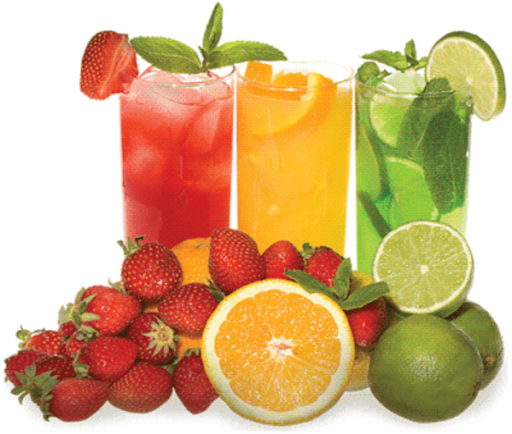
So should we consider juicing, blending, or just eating raw fruits and vegetables?
Three longitudinal prospective cohort studies found that greater consumption of fruits such as blueberries, grapes, apples, bananas, and grapefruit reduced the risk of type 2 diabetes, while greater consumption of fruit juice was associated with an increased risk of type 2 diabetes (2).
When fruit is squeezed for its juice, what is left inside is basically sugar, vitamins, and antioxidants such as carotenoids, etc.; thus, it is healthier in this aspect as compared to frizzy drinks (3). However, the amount of sugar inside both of these drinks is about the same, which is about 20–26 g of sugar per cup (3).
The reason why fruit juice contains a higher sugar content as compared to fresh fruit even when it is 100% fruit juice without the addition of anything else is because, for example, in order to make 250 ml of orange juice, two medium-sized oranges are needed, and that is only 250 ml. Since when it is in liquid form, people tend to consume it even more, thus more fruits are needed. As the number of fruits increases, so does the sugar in them, but not the fibre inside, which in turn makes them have loads of sugar (1, 3, 4, 7, 8).

According to the Singapore Health Promotion Board, many people may think that naturally occurring sugar is healthier than added sugar, but actually there is no chemical difference between the two, and they have the same impact on blood sugar levels when ingested (8).
The same case goes to smoothies, not only because they have a lot of sugar from a large number of fruits, but also because various protein-based foods like yoghurt, milk, almond milk, etc. that are mixed together with them will increase their calories as well (4).
The high sugar levels in both of these drinks make them high-calorie beverages and thus pose the same effect as high-calorie food, which can lead to weight gain. As we know, Malaysia is the fattest country in Southeast Asia, and one of the contributing factors is a lack of knowledge on what can increase weight and what cannot.
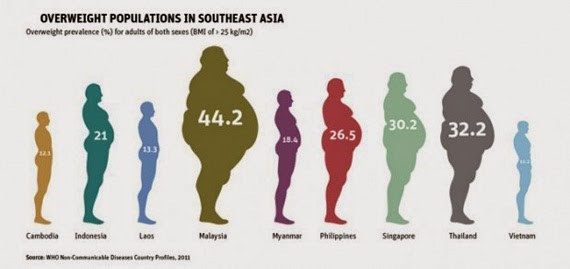
Weight gain is linked to many health problems, such as heart diseases, metabolic syndrome, cancer, bone and joint problems, kidney problems, etc. (3).
A study on the composition of grapefruits with different methods of household processing also found out that the composition of antioxidants in blended grapefruit has a higher concentration of the beneficial compound as compared to juicing or hand squeezing (5).

However, as for the absorption of beta carotene, a study found that fruit and vegetable juice makes beta carotene absorb better as compared to blending or eating raw fruit. This is due to the fact that fibre hinders the absorption of beta-carotene (6).
The takeaway message
Eating raw fruit, juicing, and blending all have their pros and cons. What is important is to always take into account the amount of sugar and fibre content. All in all, make sure that you have a balanced, nutritious, and moderate diet as suggested by the Ministry of Health: eat 3 servings of vegetables per day and 2 servings of fruits per day. Vary the way vegetables and fruit are cooked or served and eat them in moderation.
References
-
Mayo Clinic. https://www.mayoclinic.org/healthy-lifestyle/nutrition-and-healthy-eating/expert-answers/juicing/faq-20058020
-
MurakiIsao, ImamuraFumiaki, Manson JoAnn E, Hu Frank B, Willett Walter C, van Dam Rob M et al. Fruit consumption and risk of type 2 diabetes: results from three prospective longitudinal cohort studies BMJ 2013; 347 :f5001. https://www.bmj.com/content/347/bmj.f5001
-
Healthline (n.d). Is Fruit Juice is as Unhealthy as Sugary Soda? https://www.healthline.com/nutrition/fruit-juice-vs-soda#sugar-content
-
Healthline (n.d). Juicing vs Blending: Which one is better for me? https://www.healthline.com/health/food-nutrition/juicing-vs-blending
-
Ram M Uckoo1, Guddadarangavvanahally K Jayaprakasha, V M Balasubramaniam, Bhimanagouda S Patil. Grapefruit (Citrus Paradisi Macfad) Phytochemicals Composition Is Modulated by Household Processing Techniques.
-
Julia K Kolodziejczyk1, Shirley W Flatt, Loki Natarajan, Ruth Patterson, John P Pierce, Gregory J Norman. Associations of Soluble Fiber, Whole Fruits/Vegetables, and Juice With Plasma Beta-carotene Concentrations in a Free-Living Population of Breast Cancer Survivors. Women Health 52(8). DOI: 10.1080/03630242.2012.728189
-
How many orange does it take to make a cup of orange juice? (n.d). https://www.eatdifferentrd.com/blog/2016/8/12/how-many-oranges-does-it-take-to-make-a-cup-of-oj
-
Chanel News Asia (CNA) International (2019). That cup of fresh fruit juice could contain as much sugar as a soft drink. https://www.channelnewsasia.com/news/singapore/fruit-juice-sugar-diabetes-health-risks-soft-drink-11708652

How Much Sugar is Too Much Sugar?!

2015 World Health Statistics Report showed that in 2008, Malaysia had the highest obesity prevalence for adults aged ≥20 years among Southeast Asia countries. Increasing availability of sugar or sweeteners coupled with sedentary lifestyles are the contributing factor to Malaysia’s rising problem of obesity and other non-communicable disease problems (11).
On the other hand, Malaysian Adult Nutrition Survey (MANS) 2002/2003, average adult in Malaysia consumes 7 teaspoons of sugar a day comprising 4 teaspoons of table sugar and 3 teaspoons of sweetened milk into beverages. This amount exceeds the recommendation of the World Health Organization and Malaysian Dietary Guidelines (11).

Type of Sugar

Track your consumption of added sugar can be tricky, since packaged foods don’t list the number of teaspoons of sugar and some of us are getting our added sugar by spooning it onto our foods or into our beverages.
Here are the important numbers to remember:
There are 4 calories per gram of sugar and 4 grams per teaspoon. So if the label says it has 20 grams of sugar, that’s 5 teaspoons, or about 80 calories from sugar. Scan the labels for all sources of sugar in processed foods and check the number of grams of added sugars in the nutrition labels (5).
Artificial Sweeteners vs Sugar: Which is better?
Sugar substitute are known as a food additive that provides sweet taste like sugar without excess energy which can promote weight loss and deemed safe for consumption by diabetics (7). They can be either naturally produced or synthesized. Those sugar that are not natural are referred to as artificial sweeteners (9).
American Heart Association labels low-calorie sweeteners, artificial sweeteners and non-caloric sweeteners as non-nutritive sweeteners (NNSs), since they offer no nutritional benefits such as vitamins and minerals. Food and Drug Administration (FDA) has given the label “Generally Recognized as Safe” (GRAS) to five non-nutritive sweeteners such as aspartame, acesulfame-K, neotame, saccharin, sucralose and stevia. However, stevia doesn’t have a GRAS distinction but that doesn’t mean it’s dangerous, it just means there isn’t enough evidence yet either way (4).
Artificial sweeteners are thought to be beneficial for diabetics or obese as it provides sweetness without calories and a choice of sweets foods to those who cannot partake refined sugars. This artificial sweeteners may indeed restrict calories but their consumption has been shown to cause mild to serious side effects ranging from nuisance headaches to potentially life-threatening cancer.
However, artificial sweeteners are generally safe to consume but should be avoided by individual with phenylketonuria (a metabolic disorder which cannot metabolize amino acid phenylalanine found in aspartame or allergic to sulfonamides as saccharin belongs to this class of compound. In short, the consumption of artificial sweeteners may poses few health concerns but it is especially beneficial if you use them to decrease the amount of added sugar in diet. The likelihood of negative effects can vary by individual and depend on the type of artificial sweetener consumed (1). If you have bad experience or negative effects after consuming artificial sweeteners try natural sweeteners instead.
Get started cutting down on sugar with these tips
1. Consume foods or beverages low in sugar (3)
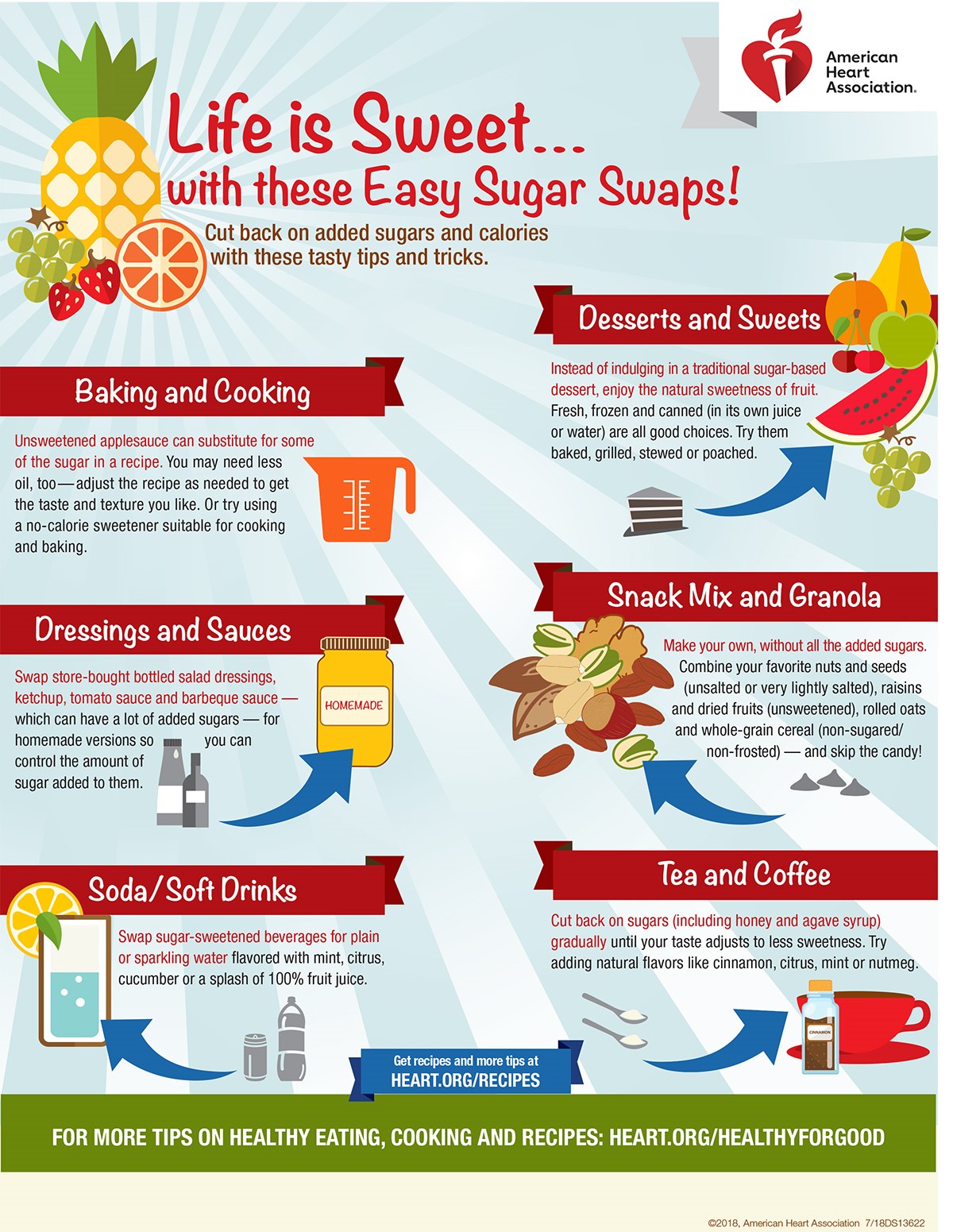
2. Focus on whole foods (8)
No sugar diet should focus on eating whole foods as processed foods are more likely to contain refined ingredients or added sugars. Aim to eat foods such as: Fruits and vegetables Lean meat or poultry whole, unprocessed grains and legumes, nuts and seeds
a)Reading the food labels and ingredients list on packaged food is a good way to know and limit how much added sugar you eat.
b) Identify the sugar content claims on packaged foods such as (6).
- Sugar Free: one serving contains less than 0.5g of sugars, both natural and added. Also: free of sugar, sugarless, no sugar, zero sugar or trivial source of sugar
- Reduced Sugar: Has at least 25% less sugars than the older version of the product. Also less sugar, low in sugar or lower sugar
- No Added Sugar: No sugar or ingredients containing sugar was added during processing or packaging. Also without added sugar or no sugar added.
References
- Alina, P. 2019. Artificial Sweeteners: Good or Bad? Healthline. Available from https://www.healthline.com/nutrition/artificial-sweeteners-good-or-bad [Accessed on 15 April 2020].
- American Heart Association. 2018. Added Sugars [online]. Available from https://www.heart.org/en/healthy-living/healthy-eating/eat-smart/sugar/added-sugars [Accessed on 15 April 2020].
- American Heart Association. 2018. Life is Sweet with These Easy Sugar Swaps-Info graphic [online]. Available from https://www.heart.org/en/healthy-living/healthy-eating/eat-smart/sugar/life-is-sweet-with-these-easy-sugar-swaps-infographic [Accessed on 15 April 2020].
- American Heart Association. 2018. Non-Nutritive Sweeteners (Artificial Sweeteners) [online]. Available from https://www.heart.org/en/healthy-living/healthy-eating/eat-smart/sugar/nonnutritive-sweeteners-artificial-sweeteners [Accessed on 15 April 2020].
- American Heart Association. 2019. By Any Other Name It’s Still Sweetener [online]. Available from https://www.heart.org/en/healthy-living/healthy-eating/eat-smart/sugar/by-any-other-name-its-still-sweetener [Accessed on 15 April 2020].
- American Heart Association. 2020. What’s the Difference Between Sugar Free and No Added Sugar [online]. Available from https://www.heart.org/en/healthy-living/healthy-eating/eat-smart/sugar/difference-between-sugar-free-and-no-added-sugar [Accessed on 15 April 2020].
- Arun, S., Amarnath, S., Thulasimani, M. and Ramaswamy, S. 2016. Artificial sweeteners as sugar substitute: Are they really safe? Indian Journal of Pharmacology 48(3): 237-240.
- Johnson, J. 2019. What to know about no-sugar diets. Medical New Today. Available from https://www.medicalnewstoday.com/articles/319991#why-cut-out-sugar [Accessed on 15 April 2020].
- Kirtida, R., T. 2011. Sugar substitutes: Health controversy over perceived benefits. Journal of Pharmacology & Pharmacotherapeutics 2(4): 236-243.
- Maria, S., V., A., Khor, G., L. and Pauline, C. 2016. Intake of added sugar in Malaysia: a review: Asia Pacific Journal of Clinical Nutrition 25(2): 227-240.
- MyHealth Ministry of Health. 2014. Facts About Sugar [online]. Available from http://www.myhealth.gov.my/en/facts-about-sugar/[Accessed on 15 April 2020].
- World Health Organization. 2015. WHO calls on countries to reduce sugars intake among adults and children [press release]. Available from https://www.who.int/mediacentre/news/releases/2015/sugar-guideline/en/ [Accessed on 15 April 2020].
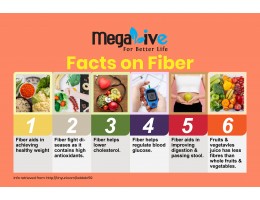
Facts on Fiber
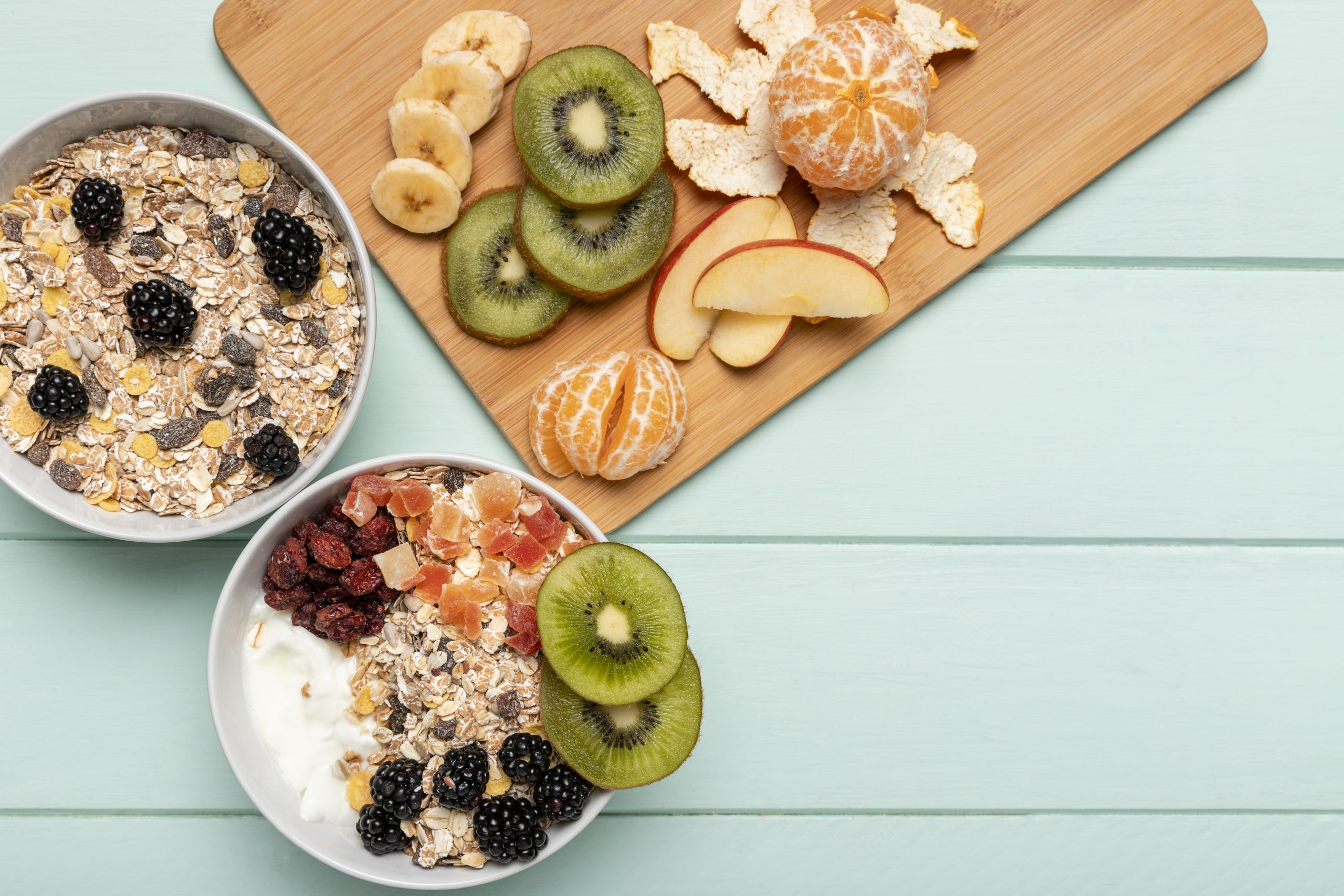
“Eat more vegetables and fruits to get your fiber!” You may have heard these words. But what is fiber, really? How it works to improve our health? Let us take a closer look on it!
Fiber is a type of carbohydrate that our body cannot digest undigested. Though most carbohydrates are broken down into sugar molecules but fiber cannot be broken down into sugar and thus it will pass through our body. These carbohydrates often considered beneficial in which mostly come from fruits, vegetables and legumes (1, 3, 6).

Soluble fiber
Dissolves in water; absorb water to form a gel like substance that slow the digestion and cause you to feel full. They have been shown to decrease cholesterol and lower blood glucose. Common source of soluble fiber includes beans, oat bran, fruits and vegetables. It is also found in pysllium, a common fiber supplement.
Insoluble fiber
Does not dissolve in water; Increase fecal bulk and appear to help food pass more quickly through the digestive tract so it can be of benefit to those who struggle with constipation and irregular stools.
Facts About Fiber (3,4)

#1 Fiber aids in achieving healthy weight.
#2 Fiber fight diseases. It appears to reduce risk of developing various health conditions including heart disease, diabetes, constipation and breast cancer.
#3 Fiber helps to lower cholesterol.
#4 Fiber helps to regulate blood glucose.
#5 Recommended dietary fiber intake per day for all age group is 20-30g/day. However, if a person is not currently eating enough of fiber, he or she should increase his or her fiber intake slowly to avoid gas and bloating.

#6 More fiber needs more water. When eating a high fiber diet, be sure to drink at least eight or more glasses of water every day.
#7 Fiber aids in improving digestion by increasing stool bulk and regularity. A high-fiber diet may help reduce the risk of hemorrhoids and diverticulitis.
#8 Too much fiber is a bad thing. You may experience abdominal cramping, bloating, gas, constipation and even diarrhea.
#9 Fruit and vegetable peels are rich in several nutrients including fiber. Eating unpeeled fruits and vegetables keep you feel full longer due to its high fiber content. However, certain fruit and vegetable peels may be hard to consume or simply inedible. These peels are best removed and not eaten.
#10 Fruits and vegetable juice has less fiber than whole fruits and vegetable. This is because the skin is removed and thus it is more healthful to eat whole fruit and vegetable.
#11 Fiber cannot be cooked out.
Tips to Increase fiber intake (5,7)
Consume products that have whole grain listed as the first ingredients, high fiber content and low fat and sugar content.
Replace white rice, bread and pasta with brown rice and whole grain products.

Include legumes in your diet (beans, dried peas and lentils)
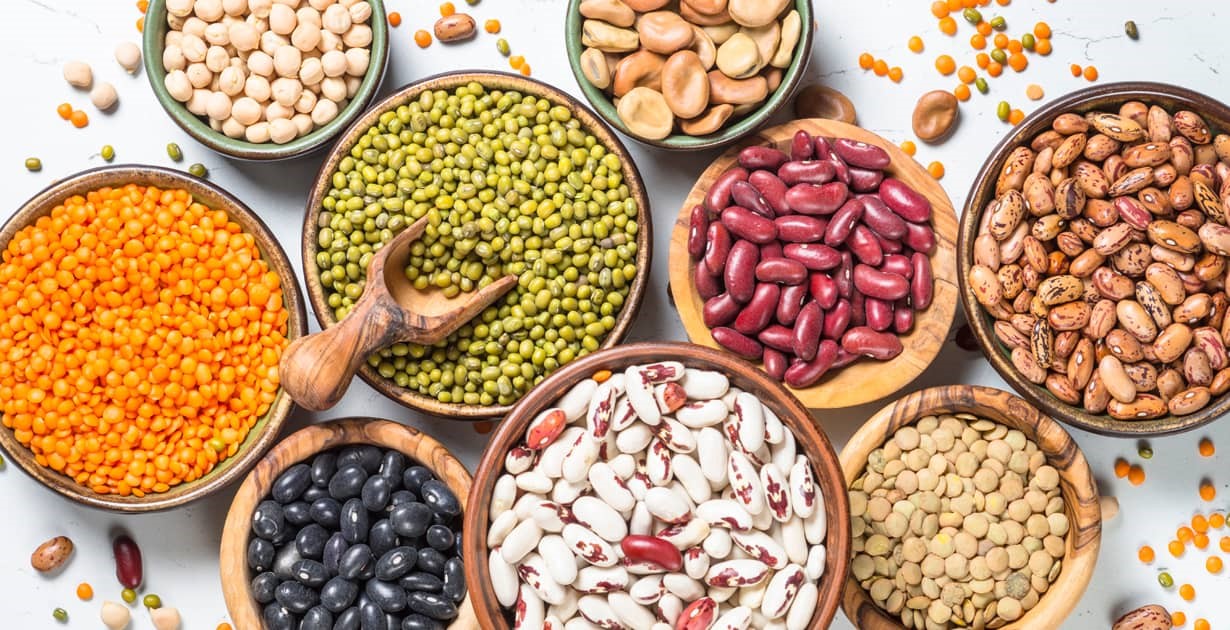
Eat unpeeled whole fruit and vegetables not juice.
Snack on fruits and vegetables
Take a fiber supplement (e.g psyllium)
In conclusion,
Fiber is an important dietary substance to your diet. This is because high fiber foods are also good sources of vitamins, mineral and antioxidants which offer many health benefits. Therefore, as one of the key ingredients to healthy eating, fiber is something you cannot skip.
References
- Cleveland Clinic. 2019. Improving Your Health With Fiber. Available from https://my.clevelandclinic.org/health/articles/14400-improving-your-health-with-fiber [Accessed on 23 April 2020].
- Danielle, D. 2018. How much fiber is too much. Medical New Today. Available from https://www.medicalnewstoday.com/articles/321286#treatment [Accessed on 23 April 2020].
- Harvard University School of Public Health. (n.d.). Fiber. Available from https://www.hsph.harvard.edu/nutritionsource/carbohydrates/fiber/ [Accessed on 23 April 2020].
- Karin, L. 2016. 45 Interesting Facts about FIber. Fact Retriever. Available from https://www.factretriever.com/fiber-facts [Accessed on 23 April 2020].
- Kerri, A., J. 2016. 16 Easy Ways to Eat More Fiber. Healthline. Available from https://www.healthline.com/nutrition/16-ways-to-eat-more-fiber [Accessed on 23 April 2020].
- Mayo Clinic. 2018. Dietary fiber: Essential for a healthy diet. Available from https://www.mayoclinic.org/healthy-lifestyle/nutrition-and-healthy-eating/in-depth/fiber/art-20043983 [Accessed on 23 April 2020].
- My Health Ministry of Health. 2012. SERAT DAN KAWALAN DIABETES. Available from http://www.myhealth.gov.my/serat-dan-kawalan-diabetes/ [Accessed on 23 April 2020].

Diabetic Neuropathy
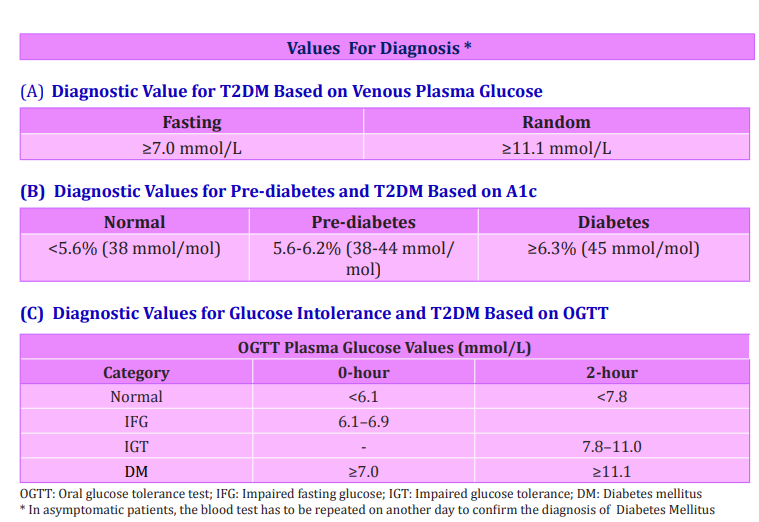
Blood glucose is the primary source of energy, and it is derived from the food that we eat. To convert this energy from food that we consume to cells, our bodies require a hormone called insulin, which is produced in the pancreas. With the help of this insulin hormone, energy from food is then converted into cells. When the body is unable to produce enough or any insulin, or when insulin is not used effectively, glucose or sugar remains in the blood and does not reach the cells (2).
Too much glucose in the blood can cause health problems over time. Although there is no cure for diabetes, individuals can take steps to manage their diabetes and stay healthy. Diabetes complications include cardiovascular disease, diabetes neuropathy (nerve damage), nephropathy (kidney damage), retinopathy (eye damage), and many others.
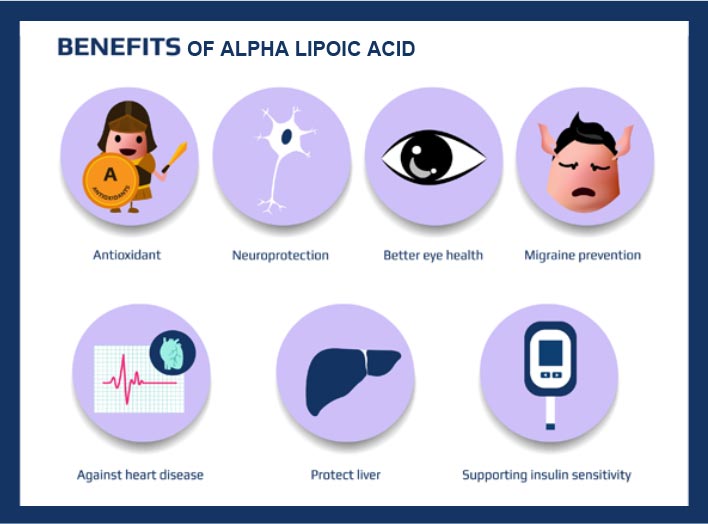
In this article, we will concentrate on the complication of nerve damage, also known as neuropathy. Excess sugar can cause damage to the walls of the tiny blood vessels (capillaries) that nourish nerves, particularly in the legs. This can cause tingling, numbness, burning, or pain, which usually starts at the tips of the toes or fingers and spreads upward. If left untreated, the individual may lose all feeling in the affected limbs (4).
Many studies are being conducted in an effort to reduce the risk of diabetic neuropathy complications, one of which is the use of Alpha Lipoic Acid (ALA). ALA is a type of antioxidant found in a variety of foods, but in very small amounts. Foods containing it include spinach, broccoli, yams, tomatoes, potatoes, carrots, beets, and rice bran. Whereas in animal-based food, the heart, liver, and kidney have higher concentrations of lipoic acid (LA) (5).
Lipoic acid (LA) can be synthesized by the human body in the liver. LA or ALA performs functions such as glucose and lipid metabolism, anti-inflammation, antioxidant property that can be used to regenerate other antioxidants, protein repair, and metal ion chelation. ALA, on the other hand, increases insulin sensitivity in people with diabetes (6).
As an antioxidant, ALA or LA aids in the fight against free radicals or oxidative stress caused by three pathways in the body of people with diabetes mellitus: mitochondrial, enzymatic, and non-enzymatic. Concerning the function of ALA in diabetes, several clinical trials have discovered that ALA may increase insulin sensitivity and help to reduce blood sugar and lipid levels.
There are two detailed studies involving this, in which ALA is administered for two weeks to 22 patients and improvements in fasting and average glucose levels, insulin sensitivity, LDL and HDL, and total cholesterol are seen, but the study is too short to measure the HBa1C level. So, another study related to this is the one that administered ALA orally to 74 patients for 4 weeks and discovered improvements in insulin resistance and fasting glucose (7).
Regarding the sole function of ALA on diabetic neuropathy, it is a possible alternative treatment for diabetic neuropathy. Diabetes causes neuropathy, or nerve damage, which is a permanent and common complication. However, ALA can help to alleviate the symptoms (8).
There are two types of neuropathy, the first of which is peripheral neuropathy, which most commonly occurs in the feet and legs but can also sometimes occur in the hands and arms. It can also cause numbness or the inability to feel changes in temperature, tingling or burning sensations, muscle weakness, a loss of balance, foot problems including ulcers or infections, sharp pain, or cramps. Whereas autonomic neuropathy can affect your autonomic nervous system, such as your heart, bladder, lungs, stomach, and intestines, this includes difficulty swallowing, constipation or uncontrollable diarrhea, bladder problems, erectile dysfunction, a decrease or increase in sweating, sharp drops in blood pressure, and many more (8).
In conclusion, studies show that ALA is able to help alleviate the symptoms of diabetes and diabetic neuropathy. However, the right management of diabetes, such as the intake of its medication, such as metformin, and diet control, together with physical activity, must be done side by side.
References
- National Institute if Diabetes, Digestive and Kidney Disease (NIDDK). United States Department of Health and Human Services. What is Diabetes? https://www.niddk.nih.gov/health-information/diabetes/overview/what-is-diabetes#:~:text=Diabetes%20is%20a%20disease%20that,to%20be%20used%20for%20energy. (Accessed on June 16, 2020).
- National Diabetes Institute of Malaysia (NADI). https://www.diabetesmalaysia.com.my/article.php?aid=8#:~:text=Your%20target%20blood%20glucose%20levels,in%20the%20last%203%20months. (Accessed on June 16, 2020).
- Clinical Practice Guideline (CPG) for Management of Diabetes Mellitus Type 2. 5th Ministry of Health Malaysia (MOH). https://www.moh.gov.my/moh/resources/Penerbitan/CPG/Endocrine/3b.pdf (Accessed on June 16, 2020).
- Mayo Clinic. Diabetes. https://www.mayoclinic.org/diseases-conditions/diabetes/symptoms-causes/syc-20371444 (Accessed on June 16, 2020).
- Alpha Lipoic Acid Supplement. https://www.webmd.com/diabetes/supplement-guide-alpha-lipoic-acid (Accesed on June 16, 2020).
- Saeid Golbidi, Mohammad Badran and Ismail Laher. Diabetes and Alpha Lipoic Acid (2011). Frontiers in Pharmacology. Journal of Pharmacology.NCBI. DOI 10.3389/fphar.2011.00069
- Diabetes Action. Alpha Lipoic Acid. https://diabetesaction.org/article-alpha-lipoic-acid#:~:text=While%20most%20of%20the%20research,of%20oxidative%20stress%20and%20inflammation. (Accessed on June 16, 2020).
- Alpha Lipoic Acid (ALA) and Diabetic Neuropathy. https://www.healthline.com/health/alpha-lipoic-acid-and-diabetes (Accessed on June 16, 2020).

DURIAN!!! Eat whole durian is equivalent to 3 bowl of rice?
Durian or ‘King of fruit’ is a well-known fruit for its smell. Anthony Bourdain, the late renowned food critic describes durian as “It smelled like you buried someone holding a big wheel of Stilton (cheese) in his arms, then dug him few weeks later” (1). That is to describe how horrible the smell of durian is, but to certain people who like to eat durian the smell of durian to them is heaven!
Durian actually has more than 30 species but the one that people usually eat are about 8 species only, due to its exotic nature, people have started to commercialized durian even to the international level. The most common durian being exported and widely consumed is Durio Zibethinus (2).

Due to its popularity, people started to questioning about durian health benefits, whether it is good or bad for health? Unlike apple, orange, guava and many other common fruits where people always equate it to “an apple a day keeps the doctor away” which means, consuming all these fruits are going to make you healthier, since it is packed full with nutrients that is good for body. For durian, the opinion regarding its health effect is mixing, some people say that it is good for health and can even be used to alleviate infertility or PCOS, Polycystic Ovarian Syndrome and some people say that it is heaty thus cannot be consumed too much etc. (3).
In general, durian is considered a safe fruit to eat just like any other fruit, but since durian has high calorie value, thus it is not advisable to consume in large amount unlike other fruits. Look at the infographic below to understand, calorie in durian in comparison with other fruits (4).

Here is the calorie of durian per seeds, surprisingly eating 5 seeds of durian is equivalent to a bowl of rice! ANDDDD IF A DURIAN CONSISTS OF 15 SEEDS IT IS EQUIVALENT TO 3 BOWL OF RICE! Thus, the recommended intake of durian is only 2-3 seeds, which is equivalent to about per serving of fruits or 90 kcal.
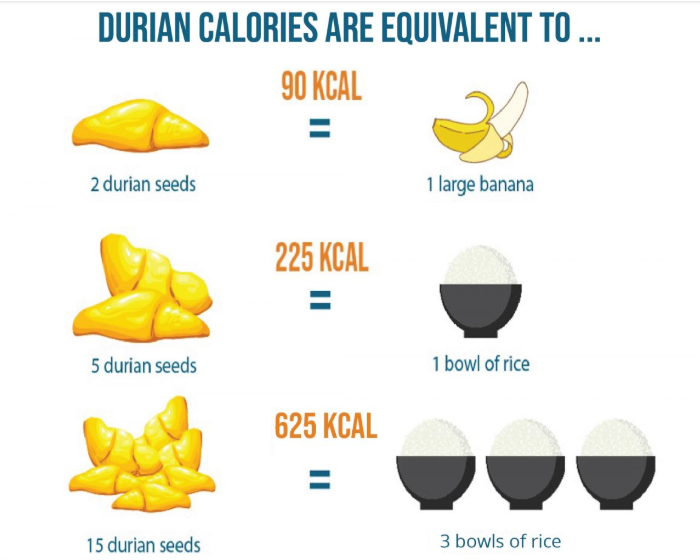
Though, it is crystal clear here that it is safe to eat durian within recommended amount, but there are people who should be even more cautious in consuming durian, that is people who are obese, people who have diabetes and people who have kidney problem. As for people who are obese and diabetes, it is due to its high calorie, high carbohydrate and high fats value thus should be extra careful on the consumption of durian. Whereas for people with kidney problem or undergoing dialysis, due to high potassium content in durian and it is difficult for their body to excrete potassium, thus, they must avoid eating TOO MUCH durian at all cost (4)!

Apart from its high calorie content durian has many benefits as well. It has high antioxidant effect, which makes it a potent fruit to fight against cancer. Durian contains high vitamins, nutrients and organic chemicals that function as antioxidant. All these antioxidants are vital in scavenging the free radicals, that potentially mutated and becoming cancer cells. Which is why it is very important to consume food that is high in antioxidant. It also contains high vitamin C, vitamin B complex and vitamin E, as well as phytonutrients that battle cancerous cells (2).
Durian also, is found to helps in maintaining healthy bones due to its high potassium content. It can help in alleviating depression and sleeping problem, for it contain tryptophan – a natural sleep-inducing compound, that can increase level of serotonin and melatonin for better sleep and emotion management. Durian also contain high fibre which can aids in digestion and helps in infertility for it has high estrogen hormone for conceiving (2).
Albeit durian has many health benefits, when it comes to its consumption with other foods and beverages such as alcohol, it is said that it can interfere with liver function. In detail, durian contain sulphur-containing volatiles which can inhibit the enzyme aldehyde dehydrogenase (enzyme that helps in process alcohol), thus explaining why consuming durian together with alcohol is a deadly mixed (4).
As for the consumption of durian with paracetamol, there is no study on human has been conducted, so far. But there is study on lab rat regarding this. The study shows that, rat that receive paracetamol and durian gives sign of hypothermic effect (significant drop in temperature) thus explain that the two mixture is toxic. However, the mechanism of toxicity is still unknown. To be safe, it is not safe to consume durian together with paracetamol (5).
In conclusion, for people who does not have any health concerns, consume durian within the recommended intake and consume it in moderation, is very much advisable. While for those who have health concerns, eat durian very minimally, it is advisable to eat other types of fruit that have lower calorie count as compared to durian, but since it is in the season thus consume it very minimally with caution towards calorie intake from other food types as well is recommended.
References
- The Star. Benefits of eating durian? Its rich in antioxidant but its fattening (2019). https://www.thestar.com.my/lifestyle/health/2019/09/10/eating-durian-healthy-or-not/ (Accessed on June 17, 2020).
- Tan M.C & Shyamala A. (2018). Exploring the Nutritional Content and Benefits of Durian (Durio Zibethinus). Institute of Bioproduct Development, Universiti Teknologi Mara. https://www.utm.my/ibd/project/exploring-the-nutritional-contents-and-benefits-of-durian-durio zibethinus/#:~:text=Durian%20is%20widely%20celebrated%20for,and%20protect%20against%20cardiovascular%20diseases. (Accessed on June 17, 2020).
- Reshma M. Ansari (2016). Potential Use of Durian Fruit (Durio Zibenthinus linn) as an Adjunct to treat Infertility in Polycystic Ovarian Synrdome (PCOS). PubMed. https://pubmed.ncbi.nlm.nih.gov/26778225/ (Accessed on June 17, 2020).
- International Medical University (IMU). Can A Durian A Day Keep the Doctor Away? http://imunews.imu.edu.my/people/can-a-durian-a-day-keep-the-doctor-away/ (Accessed on June 17, 2020).
- A. Chua., H. Nurhaslina., S.H. Gan. (2008). Hyperthermic Effect of Durio Zibethinnus and Its Interaction with Paracetamol. https://pubmed.ncbi.nlm.nih.gov/19271022/#:~:text=Because%20durian%20(Durio%20zibethinus)%2C,a%20risk%20of%20toxic%20effects

L – Carnitine: Can It Improve Diabetes?
L-Carnitine is an amino acid that the body produces. L-carnitine assists the body in converting fat into energy. In other words, L-carnitine aids the body's energy production. L-carnitine is essential for heart and brain function, muscle movement, and a variety of other processes in the body (1).
How does it work?
Many studies have found that L-carnitine can improve insulin sensitivity. It improves insulin sensitivity, allowing the body to convert food into energy. Here's a general overview of how food is converted into energy or fat in the body.
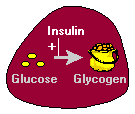
Glycogen is created when food is consumed and stored in the body until it is needed again (2). Insulin is an enzyme that converts the glucose in the food into glycogen.

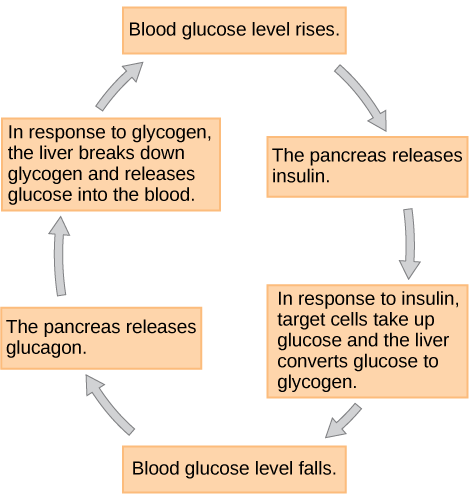
The Overall pathway
This is where L-carnitine plays its role. Mice fed a high-fat diet are able to lower their blood glucose levels when L-carnitine supplementation is given to them, as opposed to mice fed a high-fat diet without the supplement (3).
Another human study found the same result, which is that L-carnitine supplementation reduces insulin resistance and improves insulin sensitivity. The study also suggests that current diabetes patient management, which includes diet modification, medication administration, and physical activities, may be improved in the future with the consumption of supplements such as L-Carnitine (4). The study also suggests that consuming 3g of L-carnitine per day may improve diabetes symptoms, but this must be accompanied by medical professional consultation (4). However, some studies suggest that L-carnitine consumption may have some side effects, so the safe consumption level is less than 2g/day.
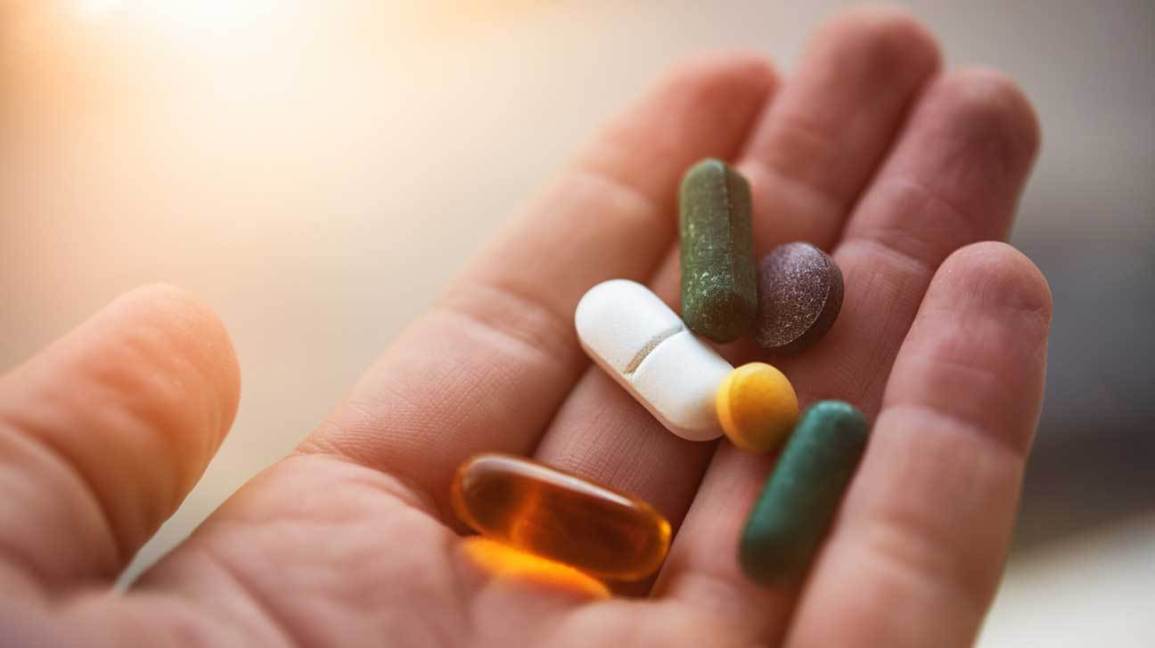
Due to the possibility that the general public might mistake it for a "magic pill" that would allow diabetes patients to eat whatever they wanted after taking it. The answer is no! A diabetes patient must still adhere to the diabetes diet, physical activity, and diabetes medication, but because diabetes is a progressive disease where the condition can worsen progressively, all actions, including supplement intake, may slow its progression (4).
Where can L-carnitine be found?
Apart from supplemented products, L-carnitines can be found naturally in foods such as beef and fish.
Beef: 81 mg/ 3 ounces
Pork: 24 mg/ 3 ounces
Fish: 5 mg/ 3 ounces
Chicken: 3 mg/ 3 ounces
Milk: 8 mg/ 3 ounces
References
-
WebMD. L – Carnitine. https://www.webmd.com/vitamins/ai/ingredientmono-1026/l-carnitine (Accessed on July 13, 2020).
-
Feedback Loop of Insulin and Glucagon. https://www.biologycorner.com/2017/08/22/feedback-loops-insulin-andglucagon/ (Accessed on July 13, 2020).
-
Randall L. Mynat (2009). Carnitine and Type 2 Diabetes. NCBI. PMC Journal. https://www.ncbi.nlm.nih.gov/pmc/articles/PMC5707127(Accessed on July 13, 2020).
-
Mingroe, Graco et al., (1999). L- carnitine Improves Glucose Disposal in Type 2 Diabetes Patient. https://pubmed.ncbi.nlm.nih.gov/10067662/#:~:text=Conclusions%3A%20L%2Dcarnitine%20constant%20infusion,also%20observed%20in%20normal%20subjects (Accessed on July 13, 2020).
-
Healthline. L – Carnitine: Benefits, Sides Effects, Sources and Dosage.https://www.healthline.com/nutrition/l-carnitine (Accessed on July 13,2020).

Diabetic Retinopathy
Diabetes is a type of chronic disease; it occurs when the glucose level in the blood is higher than normal. It is one of the leading causes of heart problems as well. In Malaysia, according to the National Health Morbidity Survey (NHMS) 2019, there are about 3.9 million people aged 18 years and older who have diabetes. Diabetes affects one out of every five adults, and the prevalence is higher in states such as Negeri Sembilan (33.2%), Perlis (32.6%), and Pahang (25.7%). The prevalence of people who have undiagnosed diabetes in Malaysia is high as well; undiagnosed diabetes occurs when people have never checked their blood glucose level in their entire life or check it rarely (1).
To understand diabetes better, it occurs when the pancreas in the body does not produce enough insulin anymore, or when the insulin is not working well anymore. Insulin is needed in order to transport glucose from the blood vessels to cells and tissues. When insulin is insufficient, glucose cannot be transported to the intended organ, thus causing a high glucose level in the blood vessels and causing damage to the organ and tissue that do not get sufficient glucose to function, and also causing damage to the blood vessels that are exposed to a high glucose level (2).
There are various complications due to diabetes, such as kidney problems, heart problems, diabetic food disease, nerve problems, and eye problems. A nerve problem is when a diabetic person starts to feel tingling and numbness in their peripherals (legs and hands), which is commonly referred to as diabetic neuropathy. Diabetic foot disease, or gangrene, occurs when a diabetic person is exposed to a wound. It must be handled with care since it can be dangerous to the extent of amputation. Eyes problem or diabetes retinopathy is the one that can lead to blindness, that we are going to discuss in detail in this article (2,3).
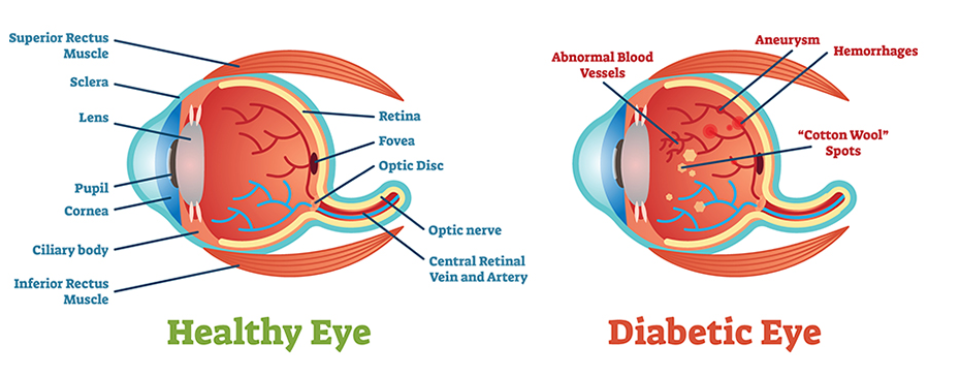
Diabetes retinopathy is the condition in which the retina is damaged, and it is a diabetic complication. When the glucose level in the blood is high, it causes a blockage in the blood vessels, causing the blood vessels to rupture easily. thus causing impaired vision and blindness (2, 3).
In the early stages, there are no significant symptoms associated with this problem; however, as things get more serious, people will experience seeing floaters or black dots in their vision. They will then start to experience obscure vision, night blindness, and diplopia (seeing a double image) (2, 3).
Risk factor to this problem includes those who have been diagnosed with diabetic in the long time (more than 5 years), those who have poor control of blood glucose level, cholesterol level, blood pressure level and low haemoglobin. Those who have gestational diabetes are also at high risk of getting diabetes retinopathy (2, 3).
There are two types of diabetic retinopathy (2,4);
Non – Proliferative Diabetic Retinopathy
Non-proliferative diabetic retinopathy (NPDR) is the early stage of the disease, in which symptoms will be mild or non-existent. In NPDR, the blood vessels in the retina are weakened. Tiny bulges in the blood vessels, called microaneurysms, may leak fluid into the retina. This leakage may lead to swelling of the macula.
Proliferative Diabetic Retinopathy
The more advanced form of the disease is proliferative diabetic retinopathy (PDR). Circulation issues deprive the retina of oxygen at this stage. As a result, new, vulnerable blood vessels can form in the retina and the vitreous, the gel-like fluid that fills the back of the eye. Blood from the new blood vessels may leak into the vitreous, clouding vision.
In order to prevent diabetic retinopathy from occurring, it is recommended for individuals with diabetes to control their blood sugar level, control their blood pressure level, stop smoking, regularly exercise, and maintain their ideal weight. Apart from these, people with diabetes may as well conduct yearly eye screenings. Eye screening for diabetics will be conducted using a fundus non-mydriatic camera, where an image of the eyes will be captured. Optometrist, eyes doctor, or eye specialist will then grade the image to see whether the eye's codition is normal or abnormal. Bleeding and swelling in the retina, an abnormal optic disk, a torn retina, and other abnormal conditions are examples of abnormal conditions.
References
- National Health Morbidity Survey (NHMS) 2019. Institute Kesihatan Umum (IKU), Kementerian Kesihatan Malaysia.
- Fatanah Ismail. Diabetes Mellitus (2008). MyHealth Portal. Kementerian Kesihatan Malaysia. http://www.myhealth.gov.my/en/diabetes-mellitus-3/ (Accessed on August 21, 2020).
- Ainayanti Adnan. Diabetis: Mesti Jalani Pemeriksaan Mata (2016). MyHealth Portal. Kementerian Kesihatan Malaysia. http://www.myhealth.gov.my/diabetes-mesti-jalani-pemeriksaan-mata/ (Accessed on August 21, 2020).
- Diabetic Retinopathy (n.d). American Optometric Association (AOA). https://www.aoa.org/healthy-eyes/eye-and-vision-conditions/diabetic-retinopathy?sso=y (Accessed on August 21, 2020).

Is artificial sweetener good for health?
Artificial sweeteners are low-calorie or calorie-free chemical substances used instead of sugar to sweeten foods and drinks. Sacharin, was the first artificial sweetener discovered in John Hopkin. It was then use widely, to the point that it was used during world war II when there was a sugar shortage, and when the shift in the perspective viewing thin figure as beauty. Sacharine is 300 times sweeter than sucrose but it has bitter after taste, which makes scientist discover cyclamate, aspartame and many more. As of 2018, there are eight Food and Drug Administration (FDA) approved artificial sweeteners which are, acesulfame K (Sunnet), aspartame (Nutrasweet), saccharin (Sweet and Low, Necta sweet), neotame (New tame), sucralose (Splenda), stevia (Truvia), advantame, and Luo Han Guo fruits extract (Nectresse).
With the advancement in the technology of discovering all these non-calorie artificial sweeteners, thousands of products ranging from drinks, desserts, ready to eat food, baby food, frozen food, and toothpaste start to use this non-calorie artificial sweeteners. But,
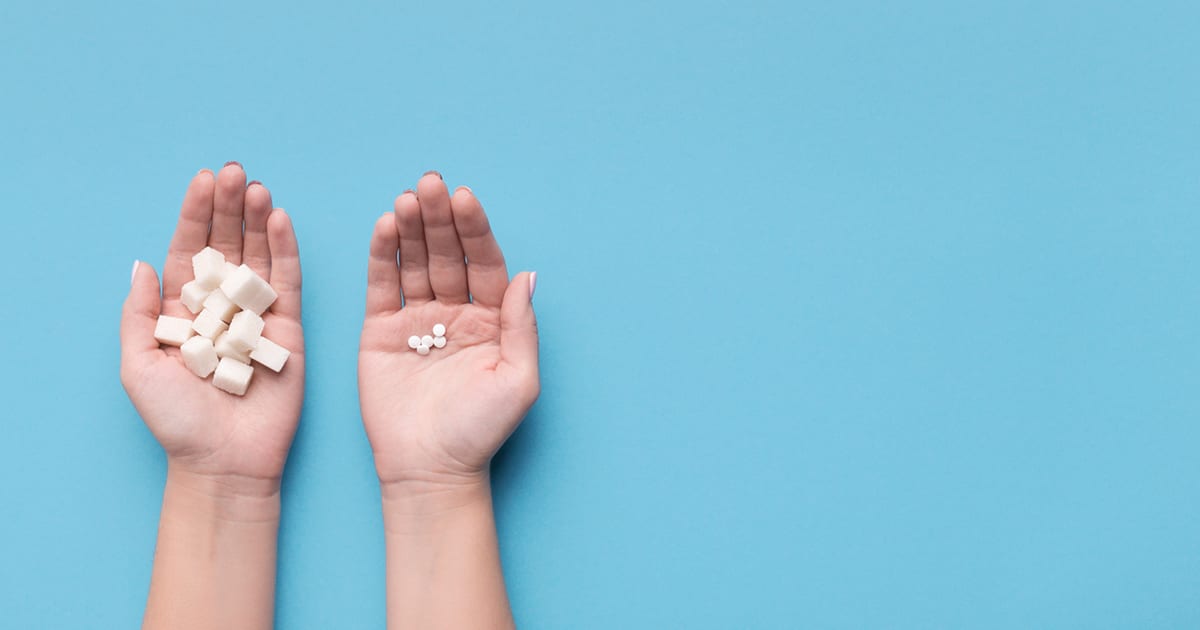
Is artificial sweetener healthy? (2, 4, 5)
Although it has been approved by FDA that it is safe to consume artificial sweeteners within the Acceptable Daily Intake (ADI), but the healthiness of artificial sweeteners is somewhat questionable though many individuals with diabetic are consuming it as a means to control their blood sugar level.
Several large-scale studies using artificial sweetener come up that the consumption of artificial sweeteners had no effect on energy intake unlike glucose or sucrose, when it does not possess any effect on the energy intake or consumption of food, it trigger a response to keep the overall energy consumption constant.
We can see this clearly in the rat model study, where rodent that is supplemented with saccharin had significantly elevated total energy intake and gain more weight with increase body adiposity (fat) compared to those that conditioned with glucose. It was seen that, rodent that was given saccharin consume more food than those that is not given saccharin.
While in the human studies, the San Antonio Heart Study that examined 3, 682 adult over seven to eight year period of time found out that BMI of those who consumed artificial sweetener is significantly increased as compared to those who do not. Nurses’ Health Study reported similar observation among children.
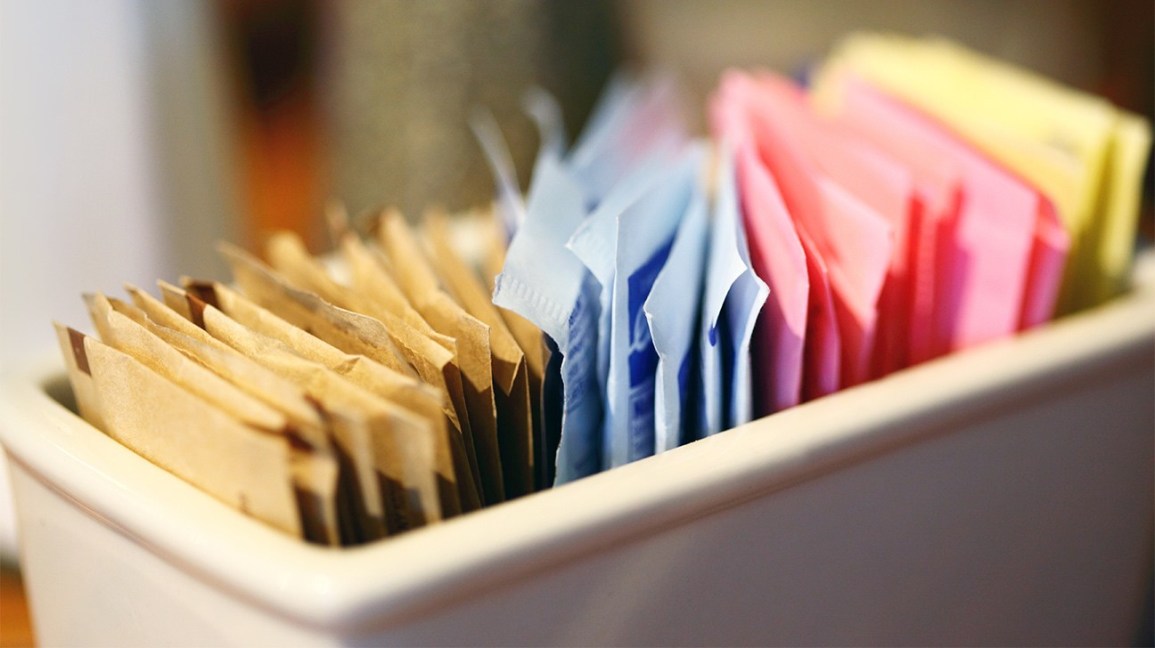
Why is that so? (2)
The explanation on this is owe to on how our brain function when we consume food. When we consume food, it is not only that our digestive system is activated but as well as our mind. Food reward system shares the same brain circuitry with other pleasurable activities such as sex and drug administration, thus share the same behavioural paradigm such as binging, withdrawal, and craving. Food rewards consist of two branches: sensory and postingestive (after eating). When we eat, our mind activates in order to tell our body that we are already full, or we feel full (satiety) or when we are satisfied with the food (mesolimbic dopamine system). Mesolimbic dopamine system is a system that is activated whenever a pleasant taste causes us to be satisfied with the food that we consumed.
However, when we consume food from artificial sweetener, it is somehow does not activate mind into signalling that we are satisfied with the food, thus those who consume artificial sweetener tend to consume more food, this trick has cause individuals to eat even more, some more thinking that they consume non-calorie artificial sweeteners, thus making them easily gain weight.

In conclusion (1)
Data on artificial sweeteners is still scarce as compared to other kind of things, where even health professionals have different take on whether it is okay for the body. To make thing safe, whatever things that we consume must always be in moderation, balance, and variety. It is very essential for individuals with diabetes to know on how to estimate their calorie intake and identify the food that can instantly spike their blood glucose level and food that will slowly increase the blood glucose level, so that they can manage their blood glucose better.
Different kind of artificial sweeteners have different level of sweetness as compared to sucrose; it also has different side effect in terms of its bitter after taste. Some of it even is not suitable to certain cooking temperature like baking. Some of it is even not suitable to certain medical condition such as phenylketonuria (PKU), a condition when an individual is unable to metabolize amino acid phenylalanine, thus cannot consume food that has phenylalanine such as aspartame.
Also, if you are considering taking artificial sweetener, do consult medical professional so they may calculate the amount needed based on your body weight per day.
References
- National Health Service (NHS). U.K. The Truth About Sweeteners. https://www.nhs.uk/live-well/eat-well/are-sweeteners-safe/ (Accessed on September 9, 2020).
- Qing Yang (2010). Gain weight by “going diet?” Artificial sweeteners and the neurobiology of sugar cravings. Department of Molecular, Cellular and Developmental Biology, Yale University. YALE JOURNAL OF BIOLOGY AND MEDICINE 83 (2010), pp. 101-108.
- S Food and Drugs Administration (FDA) (2018). Additional Information about High-Intensity Sweeteners Permitted for Use in Food in the United States. https://www.fda.gov/food/food-additives-petitions/additional-information-about-high-intensity-sweeteners-permitted-use-food-united-states (Accessed on September 9, 2020).
- Mc Clave, S., Obert, J., Casey, L. (2017). The Association Between Artificial Sweeteners and Obesity. Nutrition and Obesity. Current Gastroenterology Reports volume 19, Article number: 64 (2017).
- Brown, R. J., De Banate, M. A., & Rother, K. I. (2010). Artificial sweeteners: a systematic review of metabolic effects in youth. International Journal of Pediatric Obesity, 5(4), 305-312.

Do you know why fiber is important?
Fiber is a type of carbohydrate that our body is unable to digest. Though most carbohydrates are broken down into sugar molecules, fiber cannot be broken down into sugar molecules, and instead it passes through the body undigested. Fiber helps regulate sugars in the body and helps keep hunger and blood sugar in check.
Children and adults need at least 20 to 30 grammes of fiber per day for good health. It can be obtained by consuming a diet rich in whole grains, vegetables, legumes, nuts, and fruits.
There are two types of fiber: soluble fiber and insoluble fibre.
-
Soluble fiber is a type of fiber that dissolves in water and can help lower glucose levels and blood cholesterol levels. Foods with soluble fiber include oatmeal, nuts, beans, lentils, apples, and blueberries.
-
Insoluble fiber is a type of fiber that does not dissolve in water. It can help food move through the digestive system, promoting regularity and helping to prevent constipation. Foods with insoluble fibers are wheat, whole wheat bread, whole grain couscous, brown rice, legumes, carrots, cucumbers, and tomatoes.
There are various studies confirming that consumption of a diet high in fiber helps to make the overall body function healthier.
Heart Health
In a Harvard study with over 40, 000 male health professionals, researchers found that consumption of a high-fiber diet reduced the risk of getting coronary heart disease by 40%. Another study conducted by Harvard among female nurses also found similar findings: a high-fiber diet lowers the risk of metabolic syndrome (a combination factor of heart disease and diabetes). These factors are high blood pressure, high insulin levels, excess weight, a high triglyceride level, and a low HDL level (good cholesterol level).

Diabetes Mellitus Type 2.
A diet low in fiber and high in carbohydrates and fat can cause a sudden spike in blood sugar, which can increase the risk of developing type 2 diabetes. Both Harvard studies with female nurses and male health professionals found that this type of diet increased more than double the risk of type 2 diabetes.
Other studies, such as the Black Women’s Health Study and the European Prospective Investigation into Cancer and Nutrition, have shown similar results.
Constipation.
It is believed that the fibre in wheat bran and oat bran is more potent than the fibre found in fruits and vegetables. In addition, because fibre absorbs water, experts advise increasing beverage intake along with fibre intake rather than doing so abruptly.
Cancer.
Fiber is shown to decrease the risk of breast cancer through a large-scale study in 2016, where the findings indicate that higher fiber intake reduces breast cancer risk, suggesting that fiber intake during adolescence and early adulthood may be particularly important.
In other words, women who consume higher fiber foods during adolescence and young adulthood, including vegetables and fruits, may have a significantly lower breast cancer risk than those who eat less dietary fiber when young.
In conclusion, consumption of sufficient fiber can give various benefits to the human body. According to the Malaysia Food Pyramid 2020, it is recommended to consume 3 servings of vegetables and fruits daily. However, according to the National Health Morbidity Survey (NHMS), about 95% of Malaysians do not consume enough vegetables and fruits daily, which is why sometimes consumption of fiber supplements can help to bridge the gap of poor dietary intake.
Reference
1. Harvard T.H. Chan School of Public Health. Fiber. https://www.hsph.harvard.edu/nutritionsource/carbohydrates/fiber/
2. National Health and Morbidity Survey (NHMS) (2019). Chapter 09, Of fruits, veggies, and plain water. http://iptk.moh.gov.my/images/technical_report/2020/4_Infographic_Booklet_NHMS_2019_-_English.pdf
3. Malaysia Food Pyramid 2020. Ministry of Health Malaysia. Nutrition Division. http://nutrition.moh.gov.my/piramid-makanan-malaysia-2020-mendidik-rakyat-mengambil-makanan-dengan-betul/

Diet Suku – Suku Separuh ?
MegaLive menyambut baik saranan ini dengan turut sama mempromosikan amalan pemakanan sihat ini kepada semua.
Suku – suku separuh adalah diet yang merangkumi suku jumlah karbohidrat seperti nasi, mee, bihun, capati, roti dll, suku jumlah protein seperti ayam, ikan, sotong dll dan separuh jumlah sayur – sayuran dan buah – buahan. Pinggan yang dirujuk dalam saranan diet ini adalah pinggan berukuran 10 inci/ 25sm.
Contoh hidangan suku – suku separuh:
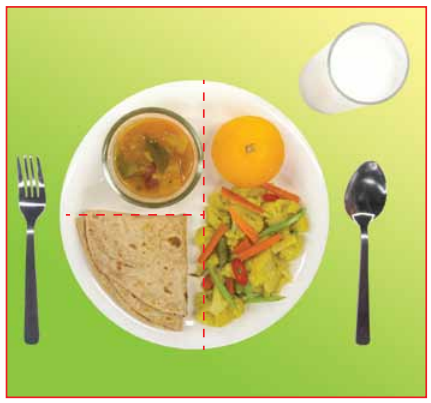
Capati dengan kuah dhal.

Nasi beras perang dengan ayam tanpa kulit dan sayur.
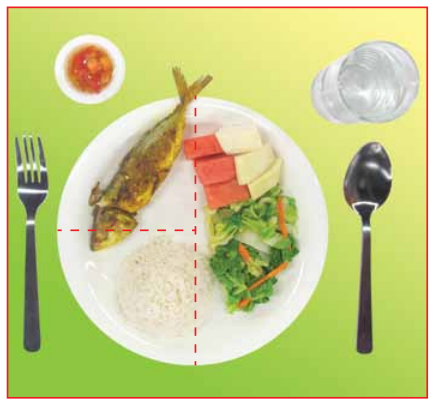
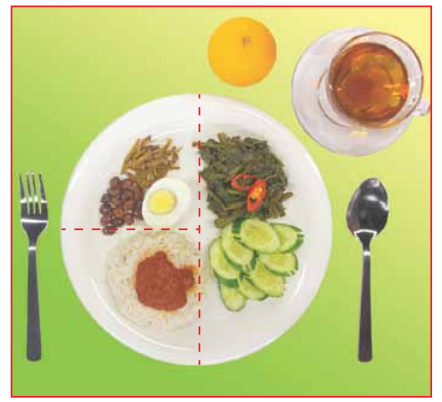
Nasi lemak
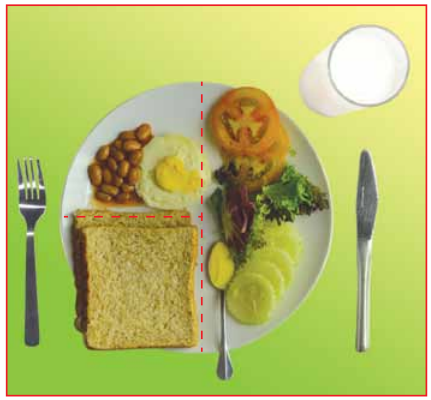
Terdapat 5 mesej utama dalam amalan diet suku – suku separuh.
Mesej Utama 1: Makan 3 Hidangan Utama yang sihat dalam sehari.
Makan sarapan, makan tengah hari, dan makan malam dengan sihat dengan mengikut konsep suku – suku separuh.
Makan pada waktu yang tetap juga membantu pengawalan porsi/ saiz hidangan makanan. Berikut adalah contoh waktu makan seharian.
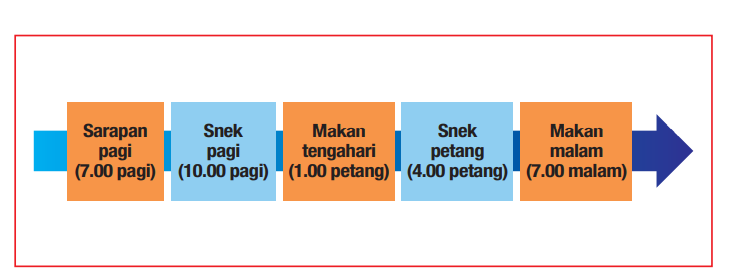
Mesej Utama 2: Makan 1-2 Snek yang Sihat di antara Waktu Makan Jika Perlu
Bagi menggalakan pemakanan secara sihat secara holistik atau sebagai gaya hidup, anda juga digalakkan untuk mengambil snek sihat 1-2 kali dari sumber buah – buahan, kekacang, dan sayur – sayuran.
Contoh snek sihat yang boleh di ambil 1-2 sajian ialah:

Mesej Utama 3: Makan Sekurang-kurangnya Separuh Daripada Bijirin Anda Sebagai Bijirin Penuh
Malaysia adalah negara di mana, makanan rujinya adalah nasi, oleh itu tidak hairanlah jika kebanyakkan rakyat Malaysia masih berasa tidak kenyang selagi tidak makan nasi. Oleh yang demikian, Kementerian Kesihatan Malaysia (KKM) menggariskan pengambilan karbohidrat hendaklah diambil kebanyakkannya dari sumber bijirin penuh, seperti dari sumber nasi beras perang, roti bijirin mil penuh, jagung, barli dll.
Contoh makanan berkarbohidrat yang tinggi serat:
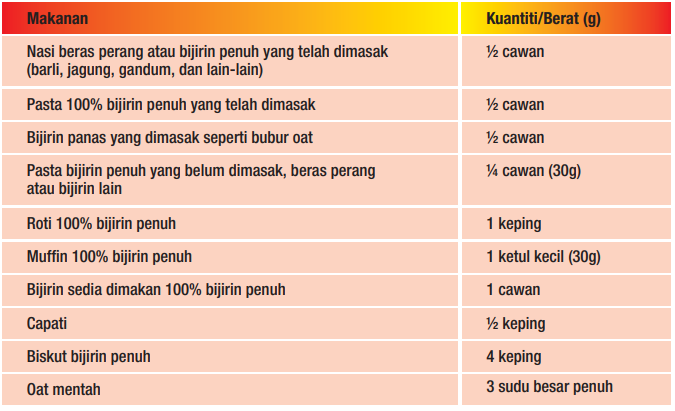
Mesej Utama 4: Makan Hidangan Tidak Bergoreng dan Tanpa Santan Setiap Hari
Seterusnya, lauk -pauk di Malaysia begitu sinonim sekali dengan jenis lauk -pauk yang bergoreng menggunakan minyak yang sangat banyak iaitu menggunakan kaedah ‘deep -frying’. Makanan bergoreng dengan minyak banyak yang digunakan secara berulang – ulang dan makanan yang mengandungi jumlah santan yang tinggi boleh meningkatkan masalah kesihatan seperti masalah jantung, darah tinggi, kolesterol dan kanser.
Justeru, pengambilan makanan dengan cara masakan dan kandungan santan yang tinggi seperti masak lemak, kari, gulai, dan masakkan bergoreng hendaklah dihadkan.
Cara mengantikan pengambilan minyak dan santan dalam masakan dan makanan:

Mesej Utama 5: Makan Makanan yang dimasak di Rumah Lebih Kerap
Makanan yang dibeli di luar secara amnya mempunyai kandungan gula, garam, sos, kicap, perasa, dan monosodium glutamate (MSG) yang tinggi, ia juga kebanyakannya menggunakan kaedah memasak yang kurang sihat iaitu dengan cara menggoreng dengan minyak yang banyak dan berulang- ulang.
Kandungan makanan yang tinggi garam, gula, sos, kicap, perasa dan MSG boleh menyebabkan tinggi risiko kepada masalah kesihatan seperti diabetes, dan juga darah tinggi.
Selain daripada itu, pengambilan makanan dari luar juga seringkali mempunyai jumlah porsi yang tidak mengikut spesifikasi suku – suku separuh, hal ini menyebabkan individu lebih cenderung untuk makaan secara berlebihan dan mendapat lebih risiko untuk menjadi obes.
Cadangan hidangan harian di rumah:

Rujukan:
- Kementerian Kesihatan Malaysia (KKM). Bahagian Pemakanan. Panduan Pinggan Sihat Malaysia. https://bit.ly/3HHHdU6

How to improve your blood circulation ?
Individuals with poor blood circulation typically experience numbness and coldness in their extremities, particularly their hands and feet. It is often the result of an underlying condition to a more serious condition, such as uncontrolled diabetes or low blood pressure, but it can also be the result of poor posture, among other things.
Here are some tips on how to
improve your blood circulation:
1. Go on regular walks
Walking can improve blood
circulation. Contraction of the calf muscle causes venous blood to be pushed
back up to the heart. The arteries dilate when patients walk and improve blood
flow throughout the body. Aim for a minimum of 30 minutes of walking three
times per week.
2.
Reduce your weight
Being obese or overweight poses a
greater health risk to your circulatory system because it increases your risk
of hypertension, high cholesterol, and diabetes, all of which lead to blood
circulatory problems.
Consumption of food in moderation,
balance and exercise regularly can help to prevent being obese and overweight.
3.
Take more breaks at work
Taking more work breaks allows you
to develop the habit of alternately sitting, standing, and walking. This
reduces the demand on the circulatory system because sitting causes blood flow
to slow and pool in your legs, resulting in muscle pain and fatigue. Thus,
taking more breaks while working in an office is beneficial for improving blood
flow and keeping your stress level in check.
Try to stretch every 15 to 20
minutes and get up and move every hour—even if it's just a power walk around
your house.
4. Stay
hydrated
When your body is dehydrated, it affects the amount of blood that
circulates through it. It also causes your blood to retain more sodium, causing
it to thicken and making it much more difficult for your circulatory system to
function properly.
Checking your pee is the simplest
way to ensure that you are getting enough fluid. A yellow light or clear urine
indicates that you are drinking enough water; anything darker indicates that
you need to up your water intake game!
5.
Manage your blood pressure
High blood pressure causes your blood circulation to go haywire,
putting more strain on your heart and blood vessels. If you do not manage your
blood pressure properly, the heart and circulatory system will have to work
harder to supply blood flow throughout the body.
High blood sugar levels can harm
the lining of small blood vessels, causing blood circulation issues. This
condition will also encourage the formation of plaque in your blood vessels,
further complicating matters.
Exercise, limiting sodium intake,
reducing stress, getting enough sleep, and making changes to your lifestyle can
all help to lower your blood pressure and improve your circulation. Ideally,
your blood pressure should be less than 120/80 mmHg.
6.
Elevate your legs.
Elevating your legs relieves
pressure on your veins because the blood does not have to work against gravity
to return to the heart.
When you are watching TV or taking
a nap, the most convenient time to elevate your legs is when you are lying down
and prop your legs above your heart level for 15 minutes or more at a time.
This will greatly improve overall blood circulation.

Growing Screen Time, Growing Vision Concerns: Protecting Children’s Eye Health in a Digital World
With digital devices becoming central to both learning and play, children are spending more time than ever in front of screens. Unfortunately, this rise in screen time has led to an increase in vision issues among children worldwide, including in Malaysia.
Studies show that globally, nearly 30% of school-aged children experience myopia (nearsightedness), a statistic that is climbing each year. In Malaysia, a recent survey revealed that over 20% of children have some form of vision impairment. This rise is linked to prolonged screen time, especially during the COVID-19 pandemic, when virtual learning became essential.
Several factors contribute to this trend. The blue light emitted from screens can cause eye strain and disrupt sleep, while focusing on close-up screens for extended periods may lead to digital eye strain or even contribute to the development of myopia. Limited outdoor time is another factor; natural sunlight is known to support healthy vision development, and children spending more time indoors tend to have higher rates of myopia.

Parents and caregivers can help protect children’s eyes by encouraging regular breaks with the 20-20-20 rule: every 20 minutes, look at something 20 feet away for at least 20 seconds. Prioritizing outdoor play also allows children’s eyes to relax from close-up screen focus. Practicing good screen habits—such as setting appropriate brightness, avoiding screens in dark environments, and keeping devices at a safe distance from the eyes—can also reduce strain.
In addition to these habits, eye health supplements and foods that are rich with nutrients thacan support children’s vision are particularly beneficial, such as lutein and zeaxanthin. Lutein and zeaxanthin act as natural filters against blue light, helping to protect the retina and maintain visual sharpness. Vitamins C and E are also powerful antioxidants that shield eye tissues from oxidative stress, promoting long-term eye health.
As digital devices become essential in daily life, it’s crucial to balance their benefits with proactive eye care. By practicing good screen habits and considering dietary support, we can help children maintain bright, clear eyesight in our fast-changing, screen-centric world.
References
-
World Health Organization (WHO): World report on vision. Geneva: WHO, 2019. This report discusses global vision health trends and the impact of screen time on vision issues, including myopia in children.
-
American Optometric Association: Digital Eye Strain and Myopia Management in Children. This provides information on digital eye strain, myopia, and best practices to mitigate eye strain for children.
-
Ministry of Health Malaysia: National Eye Survey (NES) Malaysia. This survey provides statistics on visual impairment in Malaysia, including data on children’s eye health.
-
American Academy of Ophthalmology: Recommendations on children’s screen time and its potential impact on eye health.
-
Research on Eye Supplements: Various studies on lutein, zeaxanthin, and other antioxidants for eye health, such as "Lutein and Zeaxanthin Isomers in Eye Health and Disease" (Nutrients, 2020), which details their benefits for retinal protection against blue light.




